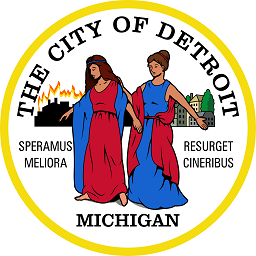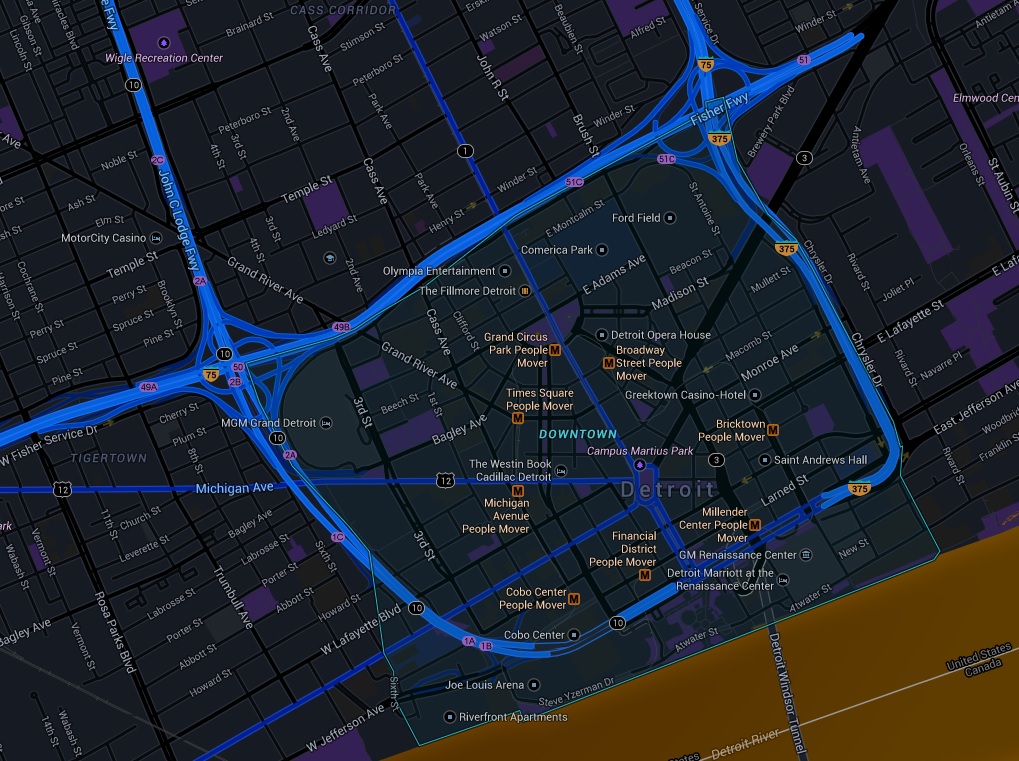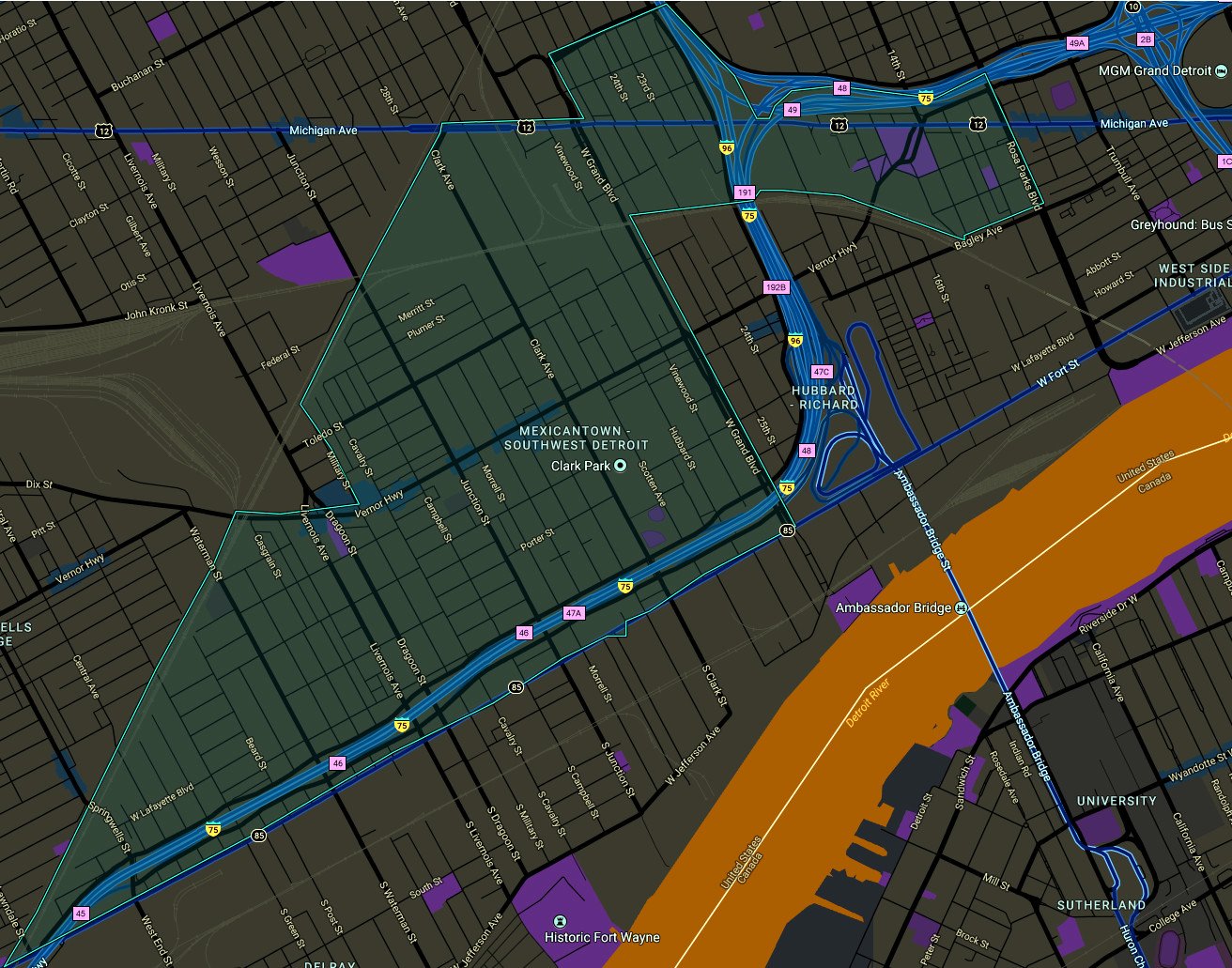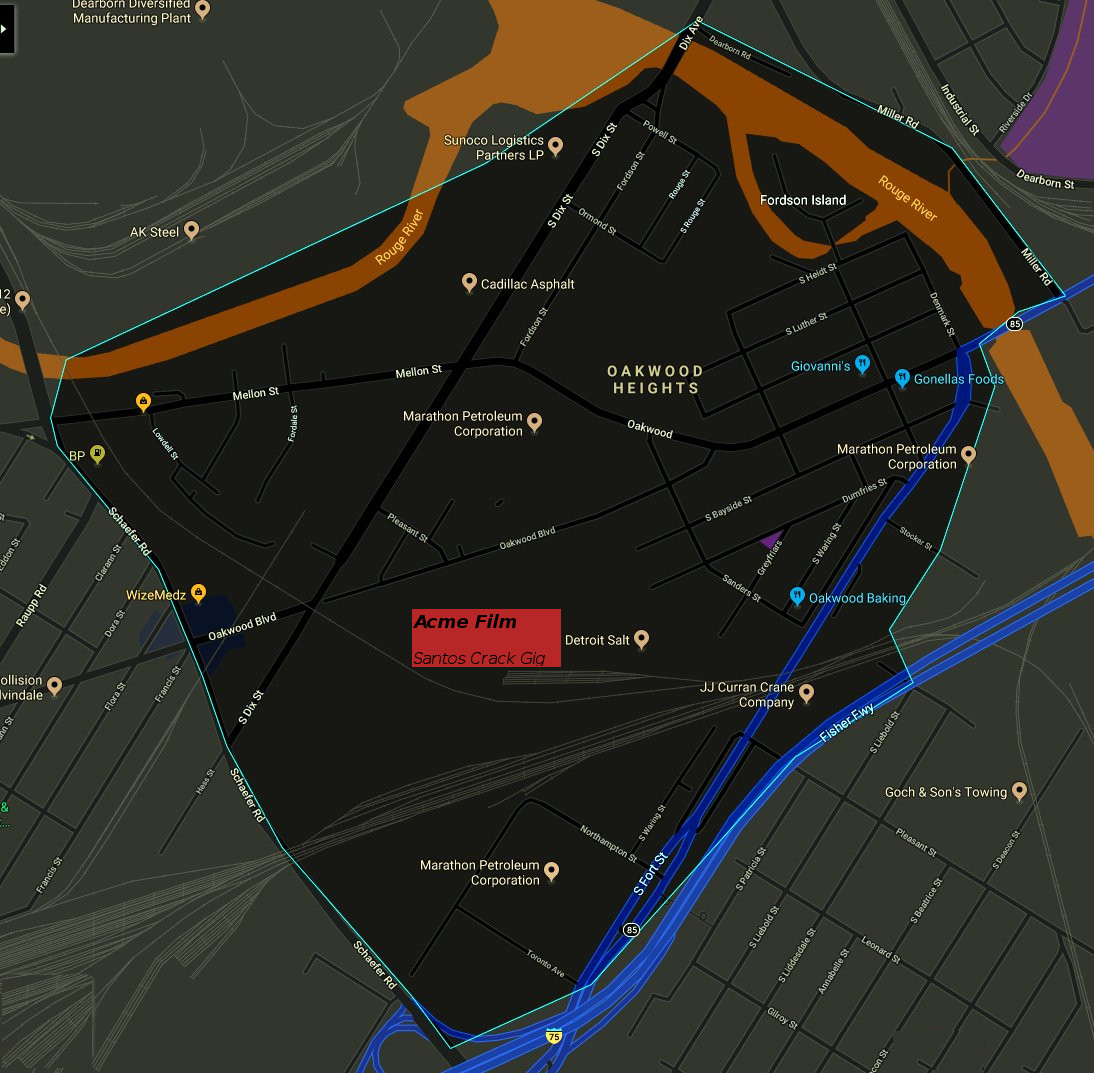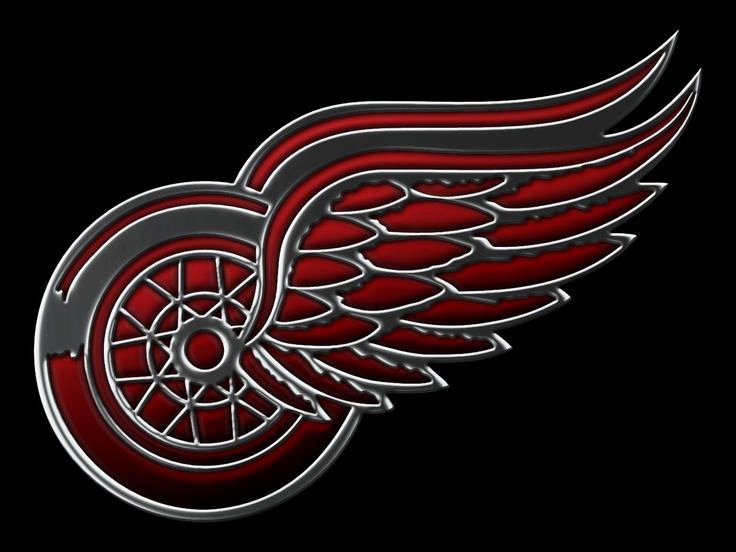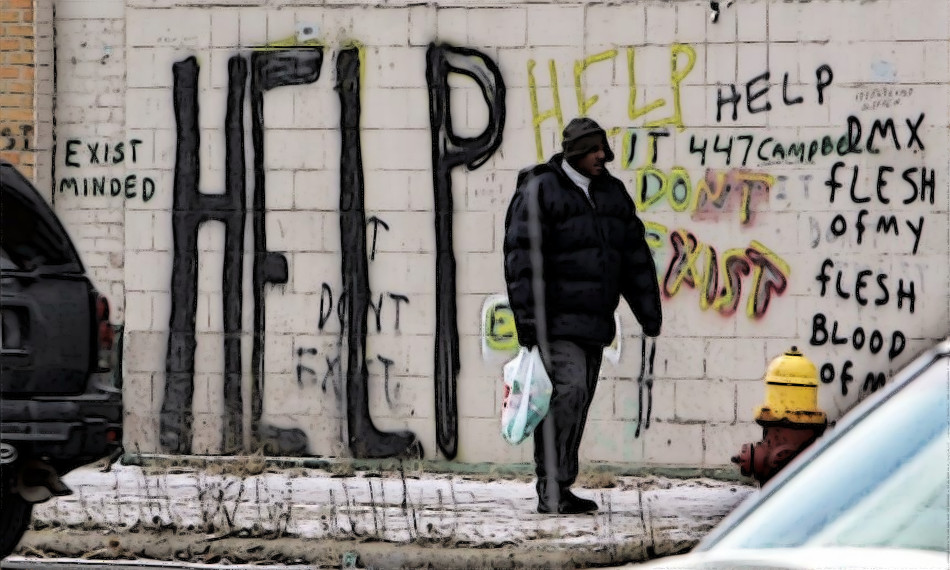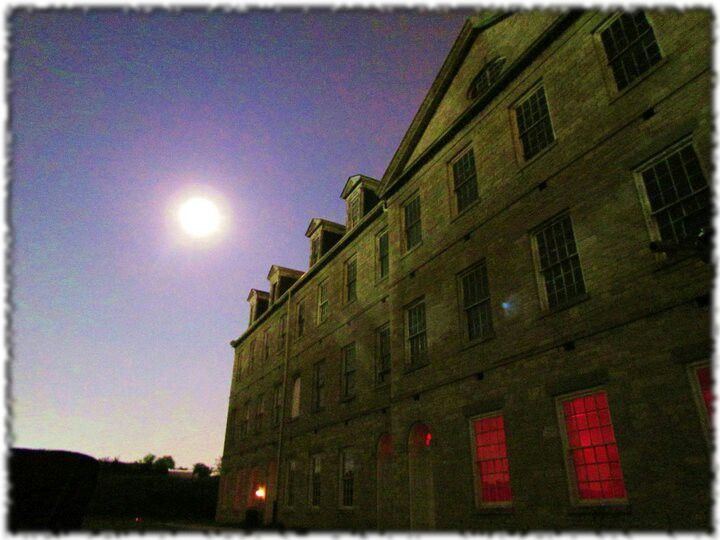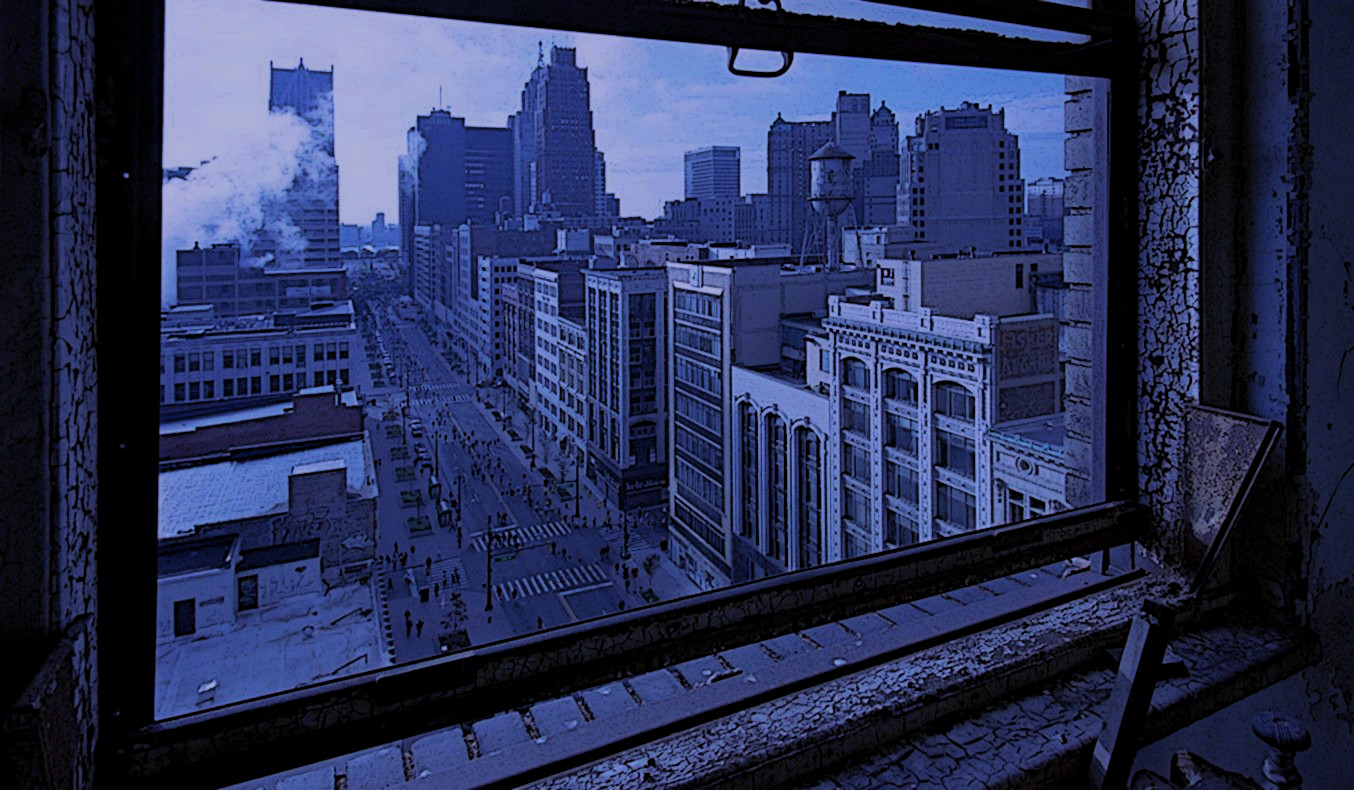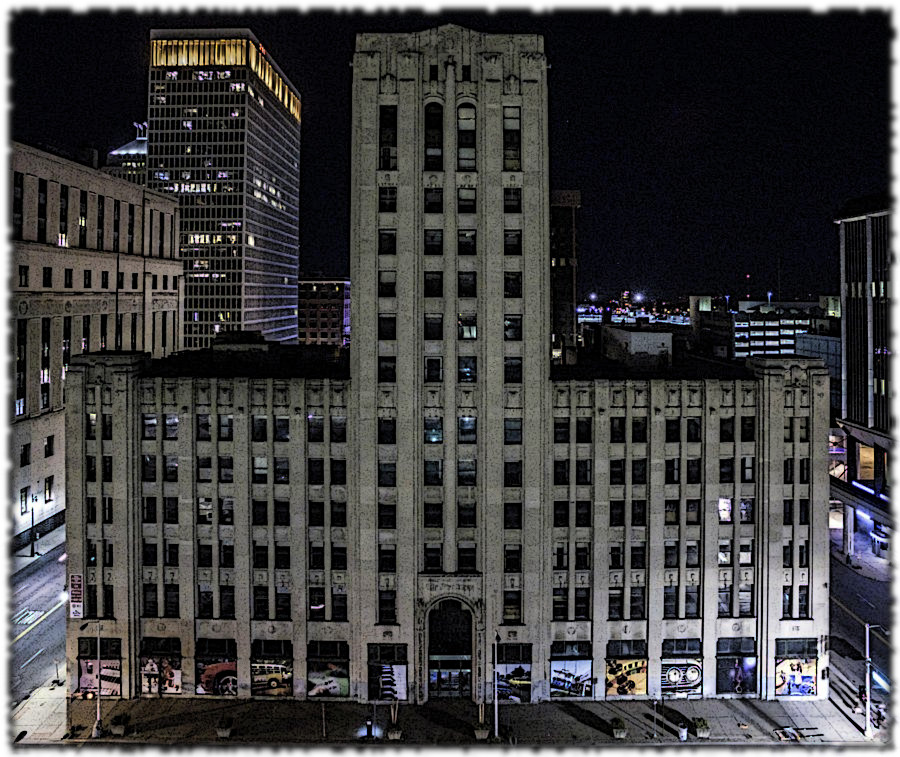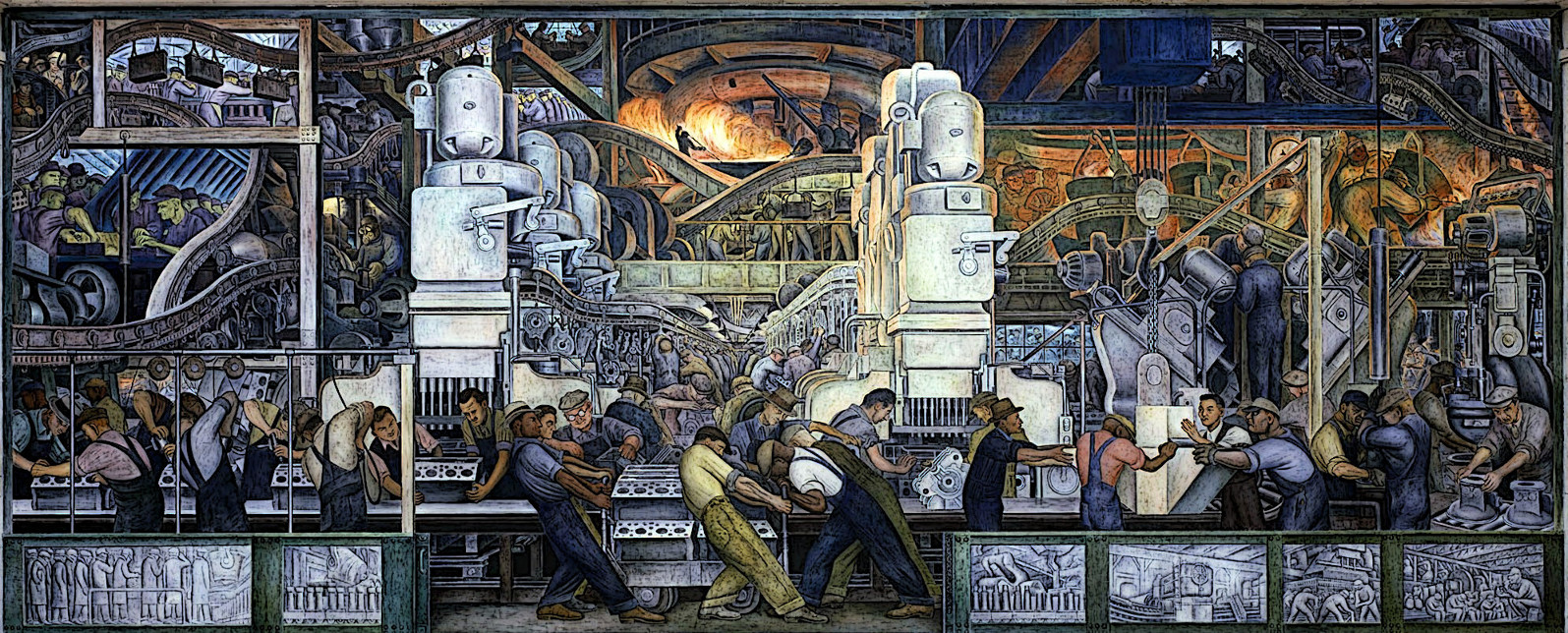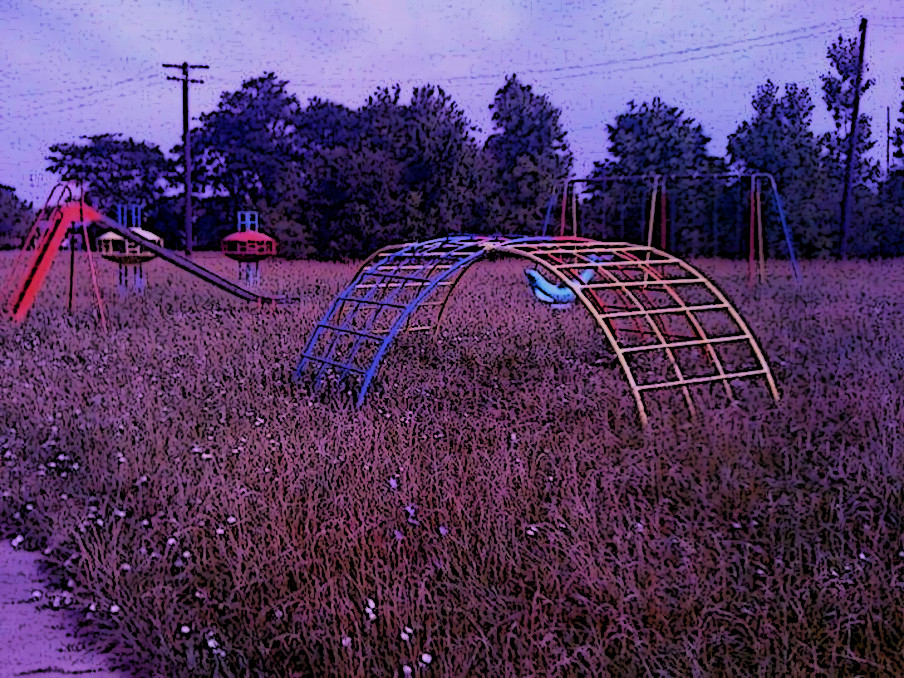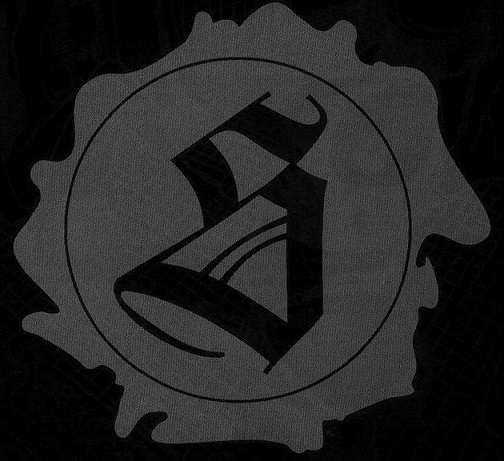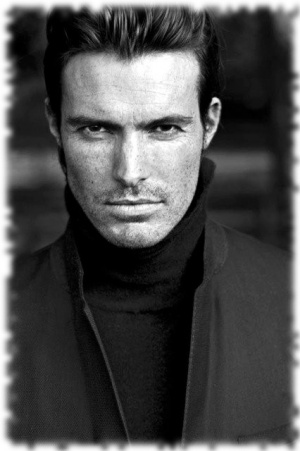Detroit
Quote

“Detroit is largely composed, today, of seemingly endless square miles of low-density failure.” -― Jane Jacobs, The Death and Life of Great American Cities
Appearance
Introduction
Detroit is the most populous city in the U.S. state of Michigan and the largest city on the United States–Canada border. It is the seat of Wayne County, the most populous county in the state. It is a primary business, cultural, financial and transportation center in the Metro Detroit area, a region of 5.3 million people. It is a major port on the Detroit River, a strait that connects the Great Lakes system to the Saint Lawrence Seaway. It was founded on July 24, 1701, by the French explorer and adventurer Antoine Laumet de La Mothe, sieur de Cadillac and a party of settlers.
The Detroit area emerged as a significant metropolitan region within the United States in the early 20th century, and this trend only hastened in the 1950s and 1960s, with the construction of a regional freeway system. Detroit is the center of a three-county Urban Area (population 3,734,090, area of 1,337 square miles (3,460 km2), a 2010 United States Census) six-county Metropolitan Statistical Area (2010 Census population of 4,296,250, area of 3,913 square miles [10,130 km2]), and a nine-county Combined Statistical Area (2010 Census population of 5,218,852, area of 5,814 square miles [15,060 km2]). The Detroit–Windsor area, a commercial link straddling the Canada–U.S. border, has a total population of about 5,700,000. The Detroit metropolitan region holds roughly one-half of Michigan's population.
Known as the world's automotive center, "Detroit" is a metonym for the American automobile industry. Detroit's auto industry was an important element of the American "Arsenal of Democracy" supporting the Allied powers during World War II. It is an important source of popular music legacies celebrated by the city's two familiar nicknames, the Motor City and Motown. Other nicknames arose in the 20th century, including City of Champions, beginning in the 1930s for its successes in individual and team sport; The D; Hockeytown (a trademark owned by the city's NHL club, the Red Wings); Rock City (after the Kiss song "Detroit Rock City"); and The 313 (its telephone area code).
Between 2000 and 2010 the city's population fell by 25 percent, changing its ranking from the nation's 10th-largest city to 18th. In 2010, the city had a population of 713,777, more than a 60 percent drop from a peak population of over 1.8 million at the 1950 census. This resulted from suburbanization, industrial restructuring and the decline of Detroit's economic strength. Following the shift of population and jobs to its suburbs or other states or nations, the city focused on reestablishing itself as the metropolitan region's employment and economic center. Downtown Detroit has held an increased role as an entertainment destination in the 21st century, with the restoration of several historic theaters, several new sports stadiums, three new stadiums, and a riverfront revitalization project. More recently, the population of Downtown Detroit, Midtown Detroit, and a handful of other neighborhoods has increased. Many other neighborhoods remain distressed and even heavily abandoned.
The Governor of Michigan, Rick Snyder, declared a financial emergency for the city in March 2013, appointing an emergency manager. On July 18, 2013, Detroit filed the largest municipal bankruptcy case in U.S. history. It was declared bankrupt by Judge Steven W. Rhodes of the Bankruptcy Court for the Eastern District of Michigan on December 3, 2013; he cited its $18.5 billion debt and declared that negotiations with its thousands of creditors were unfeasible. On November 7, 2014, Judge Rhodes approved the city's bankruptcy plan, allowing the city to begin the process of exiting bankruptcy. The City of Detroit successfully left Chapter 9 municipal bankruptcy with all finances handed back to Detroit beginning at midnight on December 11, 2014.

"Once the hub of the United States' automotive manufacturing, Detroit, Michigan has become a shell of its former industrial self. Detroit is valuable territory for the Sabbat despite its economic woes, and the sect seeks to revitalize the city with a shift in industrial focus. With one of the highest murder rates in the United States, Detroit (which has been known as "the murder capital of the U.S.") provides ample feeding grounds for its dwellers. Unlike some of their brethren to the south, the Sabbat of Detroit do not concentrate on capturing neighboring Camarilla cities. Rather, the city's vampires focus on bolstering the flagging fortunes of their home. After all, the Sabbat must have the proper resources if it is to launch a successful attack..." -- Ja'ala Eli, Keeper of Chronicles
City Device
Motto
Speramus Meliora; Resurget Cineribus -- (Latin: We Hope For Better Things; It Shall Rise From the Ashes)
Climate
Detroit and the rest of southeastern Michigan have a humid continental climate which is influenced by the Great Lakes. Winters are cold, with moderate snowfall and temperatures not rising above freezing on an average 44 days annually, while dropping to or below 0 °F (−18 °C) on an average 4.4 days a year; summers are warm to hot with temperatures exceeding 90 °F (32 °C) on 12 days.[98] The warm season runs from May to September. The monthly daily mean temperature ranges from 25.6 °F (−3.6 °C) in January to 73.6 °F (23.1 °C) in July. Official temperature extremes range from 105 °F (41 °C) on July 24, 1934 down to −21 °F (−29 °C) on January 21, 1984; the record low maximum is −4 °F (−20 °C) on January 19, 1994, while, conversely the record high minimum is 80 °F (27 °C) on August 1, 2006, the most recent of five occurrences. A decade or two may pass between readings of 100 °F (38 °C) or higher, which last occurred July 17, 2012. The average window for freezing temperatures is October 20 thru April 22, allowing a growing season of 180 days.
Precipitation is moderate and somewhat evenly distributed throughout the year, although the warmer months such as May and June average more, averaging 33.5 inches (850 mm) annually, but historically ranging from 20.49 in (520 mm) in 1963 to 47.70 in (1,212 mm) in 2011. Snowfall, which typically falls in measurable amounts between November 15 through April 4 (occasionally in October and very rarely in May), averages 42.5 inches (108 cm) per season, although historically ranging from 11.5 in (29 cm) in 1881−82 to 94.9 in (241 cm) in 2013−14. A thick snowpack is not often seen, with an average of only 27.5 days with 3 in (7.6 cm) or more of snow cover. Thunderstorms are frequent in the Detroit area. These usually occur during spring and summer.
Districts
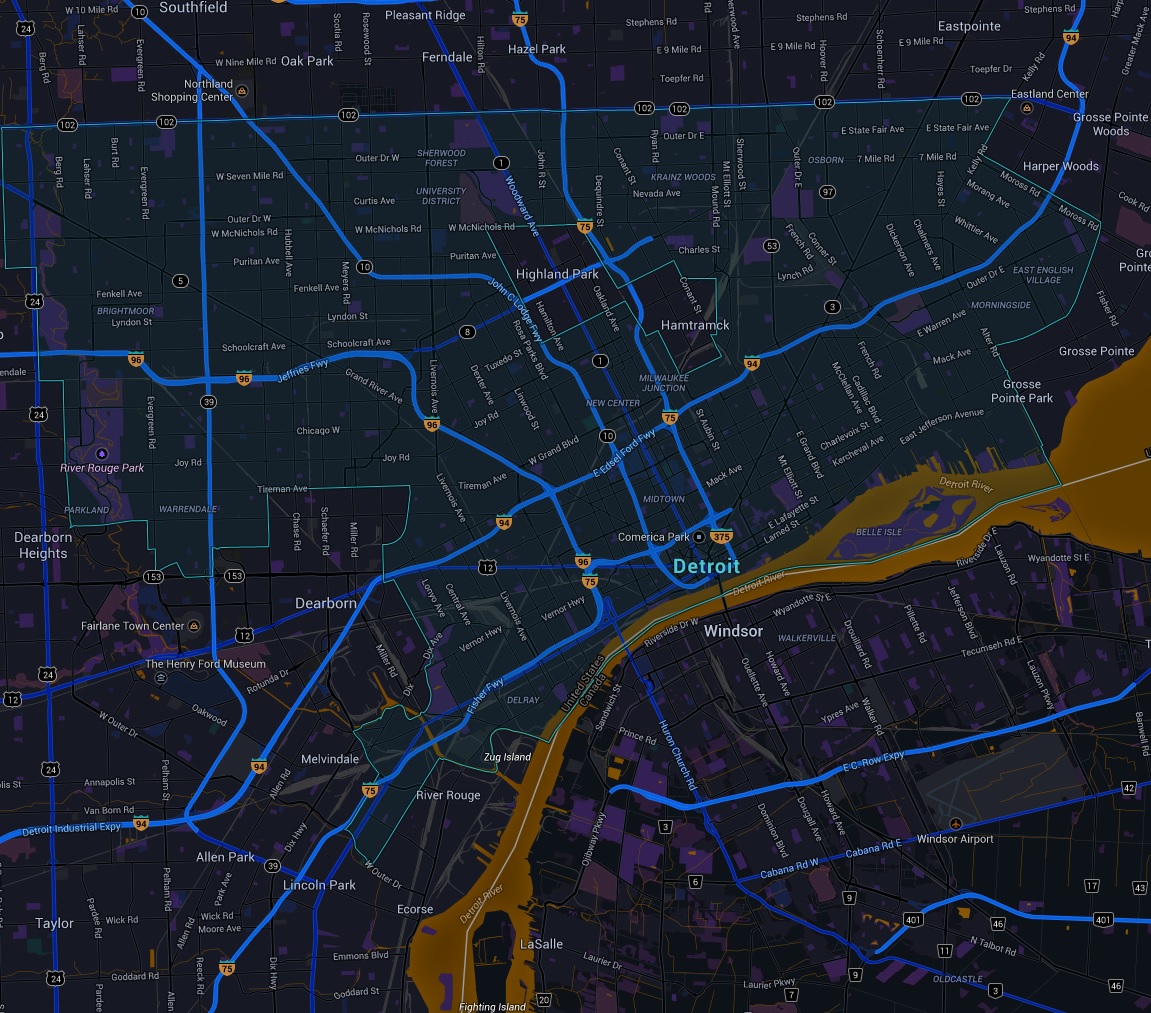
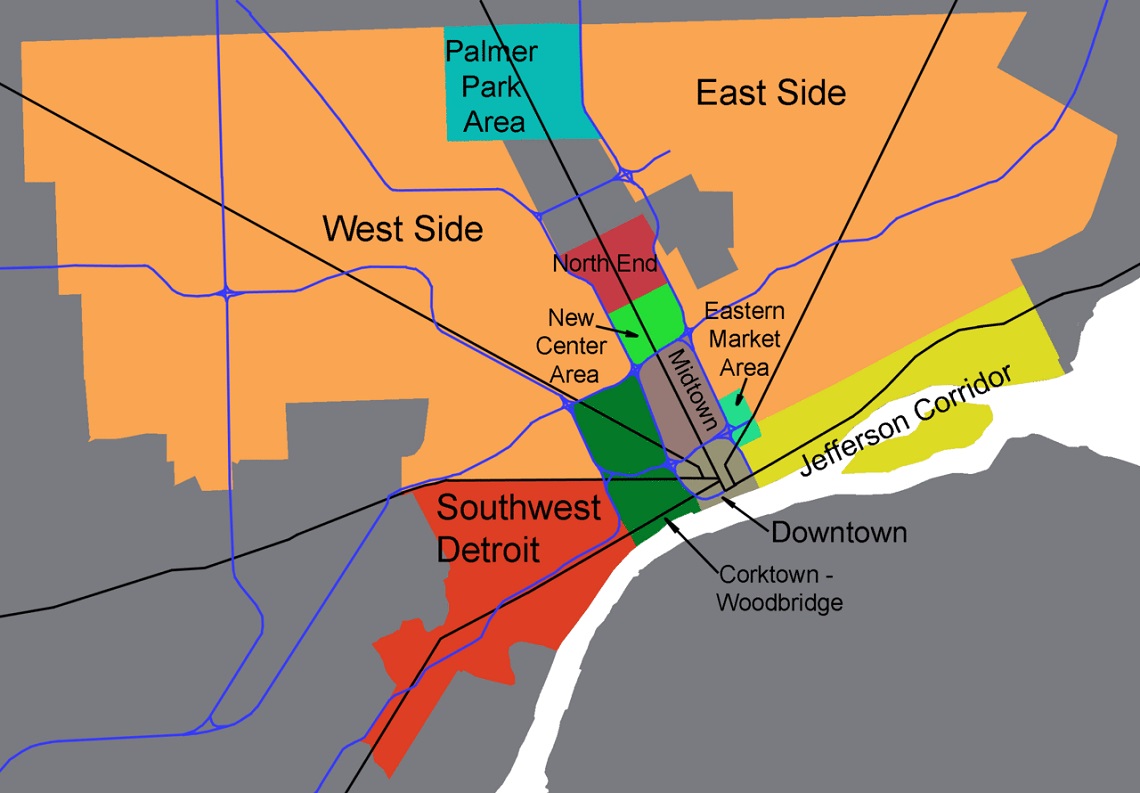
https://en.wikipedia.org/wiki/List_of_neighborhoods_in_Detroit
http://www.drawingdetroit.com/detroit-residential-vacancies-stabilize-in-late-2012/
Downtown Detroit
Midtown

Midtown Detroit is an area covering roughly two square miles between Downtown Detroit to the south and New Center to the north along Woodward Avenue. Its boundaries are the Ford, Chrysler, Fisher, and Lodge Freeways. It includes the Art Center and the Medical Center in the northeast quadrant, Wayne State University's campus, the Detroit Public Library, and the Detroit Historical Museum in the northwest, and the Cultural Center including various restaurants, galleries, newly constructed lofts/condos and nightlife venues along Woodward in the center, among other things.
Art Center two Miles (3 km) north of downtown, is centered on the Cultural Center Historic District, which is listed in the National Register of Historic Places. The Cultural Center is roughly bounded by Cass Avenue to the west, I-75 to the east, I-94 to the north and Warren Avenue to the south. It also includes the East Ferry Avenue Historic District. Attractions include the Detroit Institute of Arts, the Charles H. Wright Museum of African American History, the Scarab Club, the Detroit Historical Museum, the Museum of Contemporary Art Detroit, the main library of the Detroit Public Library system and the Detroit Science Center. The College for Creative Studies is located adjacent the Scarab Club and opposite the East face of the Detroit Institute of Arts. The main campus of Wayne State University is located adjacent to the area, on the opposite side of Woodward.
Sub-districts
Places of Interest
- Detroit Masonic Temple -- Former Tremere Chantry of Detroit, now used exclusively by the Tremere Antitribu of the Sabbat. {Cass Park Historic District}
Sources
https://en.wikipedia.org/wiki/Midtown_Detroit
New Center Area
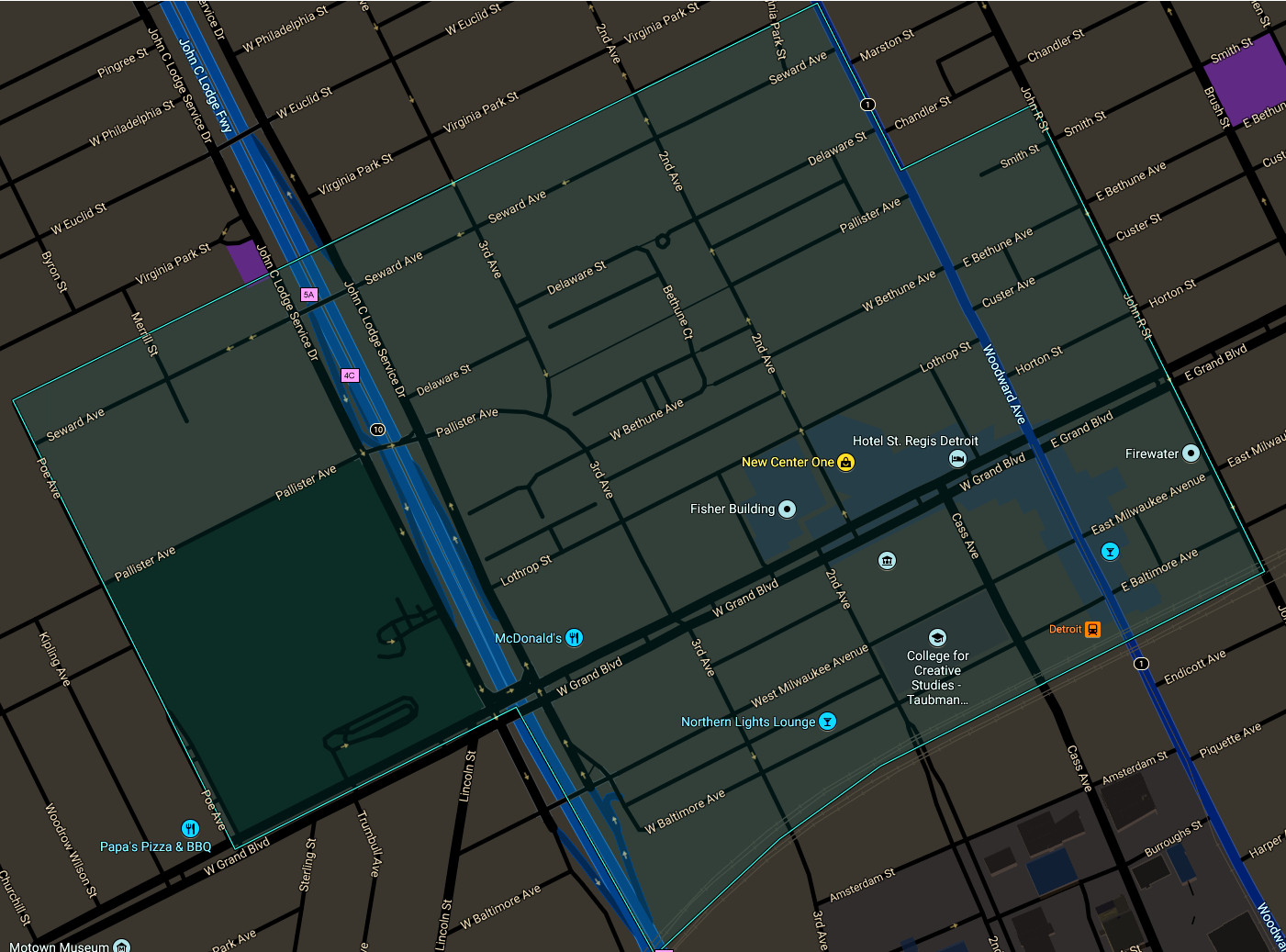
New Center is a commercial and residential historic district located uptown in Detroit, Michigan, adjacent to Midtown, one mile (1.6 km) north of the Cultural Center, and approximately three miles (5 km) north of Downtown. The area is centered just west of the intersection of Woodward Avenue and Grand Boulevard, and is approximately bounded by the Virginia Park Historic District on the north, the Edsel Ford Freeway (I-94) on the south, John R Street on the east and the Lodge Freeway on the west.
North End

The northern area includes the Detroit Golf Club and neighborhoods which surround the main campus of the University of Detroit Mercy: Pilgrim Village; Palmer Park Apartment Building Historic District; and the Palmer Woods Historic District. Pilgrim Village, developed in the 1920s, is bounded by Livernois, Idaho, Puritan and Fenkell. It is the birthplace of the Honey Baked Ham Company, which started on Fenkell in 1957. Palmer Park Apartment Building Historic District along with the nearby Palmer Woods Historic District are located within the area. Adjacent to the neighborhood is a 140-acre (0.6 km²) park named Palmer Park. The neighborhood and the park were the property of Thomas Witherell Palmer. The neighborhood consists of stately apartment buildings as well as some single-family detached homes.
Palmer Woods is known for its elm-lined streets, large brick homes, and Tudor style architecture. Palmer Woods is located on the west side of Detroit. It is bordered by 7 Mile Road, M-102 (8 Mile Road), M-1 (Woodward Avenue), and the Sherwood Forest neighborhood. Lots are large, with ample room for trees, play equipment, and a good expanse of grass. It is the home of physicians, academics, business owners, artists, executives and their families.
East Side
[[]]
Upper
Central

Central Detroit comprises three distinct areas that abut one another from south-east to north-west and include: Eastern Market, Forest Park and Poletown East.
Eastern Market

Eastern Market is a historic commercial district in Detroit, Michigan. It is located approximately one mile (1.6 km) northeast of the city's downtown and is bordered on the south by Gratiot Avenue, the north by Mack Avenue, the east by St. Aubin Street, and the west by Interstate 75 (I-75, Chrysler Freeway). The district was designated a Michigan State Historic Site in 1974 and listed on the National Register of Historic Places in 1978; the district's boundary was increased in 2007. The Eastern Market is located on the city's central east side near St. Joseph Roman Catholic Church and the Lafayette Park neighborhood. The market was transferred from city management in 2006, and now operates through a public-private partnership with the Eastern Market Corporation. Eastern Market is the largest historic public market district in the United States, and the Eastern Market farmer's distribution center is the largest open-air flowerbed market in the United States and has more than 150 foods and specialty businesses. On Saturdays, about 45,000 people shop the city's historic Eastern Market.
Forest Park
[[]]
Forest Park houses the St Albertus Roman Catholic Church and the Detroit Branch of the Federal Reserve Bank. It is a highly desirable neighborhood valued for the fact that demolition of blighted properties, beginning in 2008, started here first. As such, many tracts of land remain sparsely populated with a low density of residents.
Poletown East
[[]]
Poletown East is a neighborhood area of Detroit, Michigan bordering the enclave city of Hamtramck. The area was named after the Polish immigrants who originally lived in the area. A portion of residential area known as Poletown became the General Motors Detroit/Hamtramck Assembly plant in 1981 with those residents relocated by General Motors and the cities of Detroit and Hamtramck which claimed eminent domain in order to make way for a new automobile plant.
Lower
- Packard Automotive Plant -- A ruined automotive plant.
- The Packard Motel -- Last refuge of the fallen.
Corktown - Woodbridge
[[]]
Jefferson Corridor
[[]]
The Jefferson Corridor consists of the Eastern Market area in the south to Grosse Point Park in the north and including Belle Isle.
Eastern Market Area
[[]]
Lafayette Park
Rivertown - Warehouse District
Islandview
Gold Coast
- Manoogian Mansion -- The mayor of Detroit's primary residence.
- Erma Henderson Park
- S.V. Distant Horizon
Joseph Berry Subdivision
Marina District
Jefferson Chalmers
Southwest Detroit
Crime
- Spanish Cobras -- A slowly growning, mostly Hispanic gang that originated in 1960s Chicago. They have grown quite strong of late.
- Los Jaguares -- A relatively new, small gang from Guadalajara, Mexico. Their influence in Mexicantown is growing at an alarming rate, creating strife with their rivals, the Spanish Cobras.
- Cyan Dragons -- A Vietnamese gang that originated in Warren, Michigan. The dragons have moved in and are pressing the Spanish Cobras for territory.
Landmarks
- Ambassador Bridge -- is a tolled suspension bridge across the Detroit River that connects Detroit, Michigan, United States, with Windsor, Ontario, Canada.
- Michigan Central Station -- Former central train station for the city of Detroit. Current communal haven for the Sabbat of the city.
Neighborhoods
Corktown
Delray
Hubbard Farms
North Corktown
Mexicantown
Springwells
Westside Industrial
West Vernor–Junction Historic District
West Vernor–Lawndale Historic District
West Vernor–Springwells Historic District
Boynton–Oakwood Heights (Detroit)
Boynton and Oakwood Heights are the two southernmost neighborhoods of the city of Detroit, Michigan. They occupy the only portions of Detroit located south of the River Rouge. According to the United States Census Bureau, the two neighborhoods have a combined total area of 2.80 square miles (7.25 km²). Boynton and Oakwood Heights had a combined population of 10,516 in the 2000 census. The majority of residents reside in the larger Boynton neighborhood, as entire blocks of Oakwood Heights have been cleared out to make room for potential industrial expansion.
Located in the heavily industrialized southwestern area of Detroit, the two neighborhoods occupy the entirety of the 48217 ZIP Code. Boynton and Oakwood Heights are densely populated yet highly polluted by major industrial development. The neighborhoods are consistently ranked as the most polluted ZIP Code in Michigan.
Geography
Boynton and Oakwood Heights occupy the southernmost 2.80 square miles (7.25 km²) of the city of Detroit. It is the only area of the Detroit city limits that fall south of the River Rouge. Boynton is the southernmost neighborhood, stretching as far south as Outer Drive on the border with the city of Lincoln Park. The city of Melvindale is to the west, and the cities of Ecorse and River Rouge lie to the east. Interstate 75 (I-75) bisects the two neighborhoods north–south. Oakwood Heights is the smaller of the two neighborhoods and borders Melvindale to the south and the city of Dearborn to the northwest.
The two neighborhoods are connected to the rest of the city of Detroit by two bridges across Interstate 75 and Fort Street (formerly known as U.S. Route 25) connecting to the neighborhood of Carbon Works, which lead to the neighborhoods of Springwells and Delray. Dix Avenue also crosses the river to connect Oakwood Heights to Dearborn. Oakwood Heights also connects to Fordson Island in the River Rouge via Riverside Drive. Fordson Island is part of the city of Dearborn and has no public access or residents.
Fordson Island: http://detroitfunk.com/fordson-island/
Despite the heavy industrialization, several parks exist within the area. Kemeny Park, located along Fort Street in between I-75, is the largest recreation facility. The park opened in 1957 and was named after local resident Charles Kemeny, who died in combat in World War II.
Demographics
Officially, the areas of Boynton–Oakwood Heights had 8,832 people and 3,126 occupied households for an average density of 5,428.4 people per square mile (2,095.9/km²). There were 716 vacant units.
According to the most recent estimates, the racial makeup of the two neighborhoods was 10.38% White, 74.80% African American, 0.67% Native American, 0.46% Asian, 0.10% Pacific Islander, 0.01% from other races, and 2.60% from two or more races. Hispanic or Latino of any race were 10.94% of the population. While there was estimated to be 12,129 residents in 1999, the census officially accounted for only 8,832. The majority of the population lives in Boynton.
The median income for a household in these neighborhoods was $26,316, and the median income for a family was $28,789. About 27.3% of the population was below the poverty line.
Transportation
Interstate 75, known locally as the Fisher Freeway, runs north–south through the Boynton and Oakwood Heights neighborhoods and has two exits: Outer Drive (#42) and Schaefer Highway (#43). Outer Drive represents the southernmost border of the Boynton neighborhood and the southernmost city limit of Detroit with Lincoln Park. The Schaefer Highway (also referred to as Coolidge Highway at various points along its route) runs northwest through the neighborhoods, beginning just east in the city of River Rouge and running north all the way to the city of Rochester Hills. Fort Street (formerly U.S. Route 25) runs north–south through the middle of the neighborhoods, passes under Interstate 75, and crosses the River Rouge leading into Downtown Detroit. Several Norfolk Southern Railway lines runs through the Oakwood Heights section.
The Detroit Department of Transportation operates three bus routes through Boynton and Oakwood Heights. Route #41 travels along Schaefer Highway from the city of River Rouge at Jefferson Avenue, through parts of Dearborn, and to the northern limits of Detroit at 8 Mile Road at the city of Oak Park. Route #19 travels from Outer Drive along Fort Street to Downtown Detroit. Route #89 is a part-time route that runs along Bassett Street from Outer Drive along the border with the city of River Rouge, turns on Schaefer Highway, across the river, and meanders into the New Center district.
Oakwood Heights has one property listed on the National Register of Historic Places: the Fort Street – Pleasant Street and Norfolk & Western Railroad Viaduct, which was constructed in 1928. The 2,800-foot-long (850 m) bridge carries six lanes of Fort Street over Pleasant Street and four Norfolk Southern Railway lines before crossing the River Rouge; unfortunately, the bridge is slowly crumbling as the heavy traffic takes its toll and its only a matter of time before a partial or complete collapse occurs.
Education
Being part of Detroit, residents of Boynton and Oakwood Heights are automatically zoned to Detroit Public Schools Community District. Students are currently zoned to Mark Twain School for Scholars for elementary and middle school through eighth grade. High school students are zoned to Western International High School.
While the two neighborhoods contain no public libraries, the nearest Detroit Public Library is the Campbell Branch at 8733 West Vernor Highway just north in the Springwells neighborhood. Also, the Lincoln Park Public Library is about one mile south of Boynton at 1381 Southfield Road in Lincoln Park.
Industry
While at least 14 states regulate and prohibit how close industries can build to schools and residential zones, Michigan does not have such regulations. Long ago, the city zoned its southwest area for heavy industrial use despite preexisting residential communities. Air pollution in Boynton and Oakwood Heights has reportedly led to respiratory diseases and cancer cases in long-term residents. In an article published by the Detroit Free Press in June 2010, they reported, "For the past six months, a rain of mysterious sparkly dust of unknown origin has landed on their homes and gardens. Odd odors and clouds of dark particles float overhead." This dust pollution has been shown to contain high levels of harmful metals, such as lead, that can be harmful to the health of long-term residents. Even the soil may be unsuitable for growing gardens.
The Detroit Free Press stated that the 48217 ZIP Code—occupied solely by Boynton and Oakwood Heights—is "Michigan's most polluted [ZIP Code], according to analysis by environmental scientists from the University of Michigan." Halting the growing industries could discourage job growth, and the state continues to issue permits for heavy industries. Industries comply with both state and federal regulations. However, the number of industries proximate to the neighborhoods has a cumulative effect. Heavy traffic and railroads have also increased air pollution, as do numerous other large industries outside of the neighborhoods. Among these industries, the Detroit Wastewater Treatment Plant on the other side of the river and the U.S. Steel facility on Zug Island in the city of River Rouge further add to the poor air quality in the area.
Marathon Petroleum Corporation
The largest of these industries is the Marathon Petroleum Company LP refinery located at 301 South Fort Street in Oakwood Heights. The facility was originally built in 1930 by the Aurora Gasoline Company. Today, the expanded facility is the only petroleum refinery in Michigan, and it has a capacity of 140,000 barrels per day and around 540 employees. The refinery received the Energy Star Award in 2007 and 2008 from the Environmental Protection Agency for reducing energy usage and protecting the environment through energy efficiency. The refinery has added green space around its facility, although it is still viewed negatively by the surrounding communities.
The Michigan Department of Environmental Quality has issued 13 violations to the facility since 2013 and at least three fines, especially after a massive cloud of burned petroleum coke blanketed the area and even blew into neighboring Windsor on July 27, 2013. In February 2019, a malfunctioning flare from the facility released "horrific, stomach churning odors" that forced some residents to stay indoors. In response to the growing criticism, Jamal T. Kheiry, communications manager for Marathon wrote, "Over the past 20 years, we have reduced our emissions more than 75 percent, and the refinery comprises only 3 percent of the emissions in this heavily industrialized area of Southwest Detroit."
The refinery has received permission for an expansion of its facilities and has sought to buyout properties in the Oakwood Heights community. It remains unclear if Marathon would actually expand into the area or if they are just buying out nearby properties to create a larger buffer from the remaining communities in order to avoid further complaints. The neighborhood of Oakwood Heights once contained about 500 homes, but large areas and entire blocks have been bought out and demolished. Many local residents welcomed the buyout as a means to leave the area. Marathon offered 350 homeowners buyout packages totaling nearly $60,000 per home in the Oakwood Heights community, even though some homes were valued at much less. A similar offer was requested but not granted to the Boynton community, which has few major industries itself and is mostly separated from the facility by Interstate 75 and Fort Street. Not all residents have accepted Marathon's offer, as the company cannot force residents to move out. Those residents that have stayed are growing concerned that the empty space and general neglect of the neighborhood will increase crime. Feeling Oakwood Heights has become abandoned, some have complained that local police have become unresponsive to their calls.
Oakwood Heights
Boynton
Palmer Park Area
[[]]
East Side
[[]]
West Side
[[]]
Independent Cities of the Detroit Metro
Hamtramck -- Michigan's most ethnically diverse city.
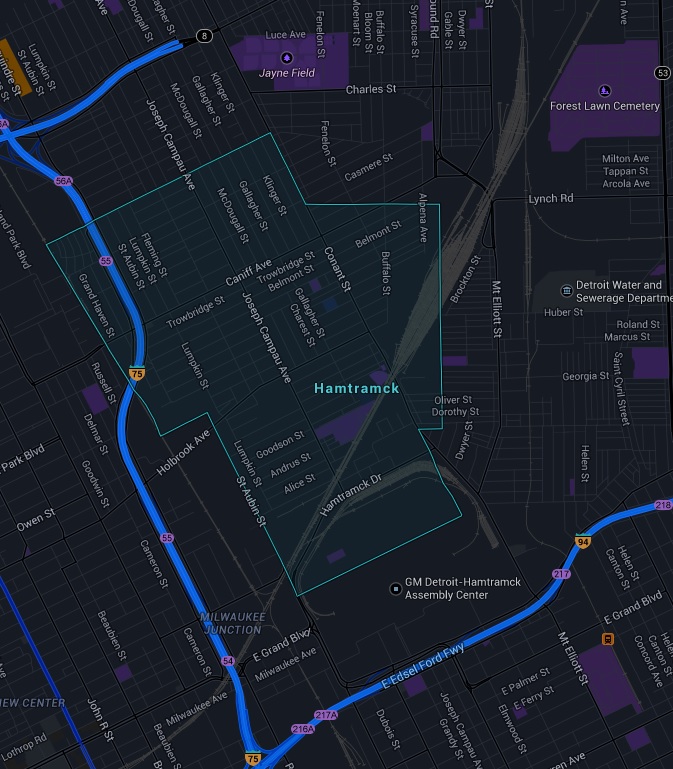
http://en.wikipedia.org/wiki/Hamtramck,_Michigan
Highland Park

http://en.wikipedia.org/wiki/Highland_Park,_Michigan
Demonym
Detroiter
Economy
Several major corporations are based in the city, including three Fortune 500 companies. The most heavily represented sectors are manufacturing (particularly automotive), finance, technology, and health care. The most significant companies based in Detroit include: General Motors, Quicken Loans, Ally Financial, Compuware, Shinola, American Axle, Little Caesars, DTE Energy, Lowe Campbell Ewald, Blue Cross Blue Shield of Michigan, and Rossetti Architects.
About 80,500 people work in downtown Detroit, comprising one-fifth of the city's employment base. Aside from the numerous Detroit-based companies listed above, downtown contains large offices for Comerica, Chrysler, HP Enterprise, Deloitte, PricewaterhouseCoopers, KPMG, and Ernst & Young. Ford Motor Company is located in the adjacent city of Dearborn.
Thousands more employees work in Midtown, north of the central business district. Midtown's anchors are the city's largest single employer Detroit Medical Center, Wayne State University, and the Henry Ford Health System in New Center. Midtown is also home to watchmaker Shinola and an array of small and startup companies. New Center bases TechTown, a research and business incubator hub that is part of the WSU system. Like downtown and Corktown, Midtown also has a fast-growing retailing and restaurant scene.
A number of the city's downtown employers are relatively new, as there has been a marked trend of companies moving from satellite suburbs around Metropolitan Detroit into the downtown core. Compuware completed its world headquarters in downtown in 2003. OnStar, Blue Cross Blue Shield, and HP Enterprise Services are located at the Renaissance Center. PricewaterhouseCoopers Plaza offices are adjacent to Ford Field, and Ernst & Young completed its office building at One Kennedy Square in 2006. Perhaps most prominently, in 2010, Quicken Loans, one of the largest mortgage lenders, relocated its world headquarters and 4,000 employees to downtown Detroit, consolidating its suburban offices. In July 2012, the U.S. Patent and Trademark Office opened its Elijah J. McCoy Satellite Office in the Rivertown/Warehouse District as its first location outside Washington, D.C.'s metropolitan area.
In April 2014, the Department of Labor reported the city's unemployment rate at 14.5%.
The city of Detroit and other private-public partnerships have attempted to catalyze the region's growth by facilitating the building and historical rehabilitation of residential high-rises in the downtown, creating a zone that offers many business tax incentives, creating recreational spaces such as the Detroit RiverWalk, Campus Martius Park, Dequindre Cut Greenway, and Green Alleys in Midtown. The city itself has cleared sections of land while retaining a number of historically significant vacant buildings in order to spur redevelopment; though it has struggled with finances, the city issued bonds in 2008 to provide funding for ongoing work to demolish blighted properties. Two years earlier, downtown reported $1.3 billion in restorations and new developments which increased the number of construction jobs in the city. In the decade prior to 2006, downtown gained more than $15 billion in new investment from private and public sectors.
Despite the city's recent financial issues, many developers remain unfazed by Detroit's problems. Midtown is one of the most successful areas within Detroit to have a residential occupancy rate of 96%. Numerous developments have been recently completely or are in various stages of construction. These include the $82 million reconstruction of downtown's David Whitney Building (now an Aloft Hotel and luxury residences), the Woodward Garden Block Development in Midtown, the residential conversion of the David Broderick Tower in downtown, the rehabilitation of the Book Cadillac Hotel (now a Westin and luxury condos) and Fort Shelby Hotel (now Doubletree) also in downtown, and various smaller projects.
Downtown's population of young professionals is growing and retail is expanding. A study in 2007 found out that Downtown's new residents are predominantly young professionals (57% are ages 25 to 34, 45% have bachelor's degrees, and 34% have a master's or professional degree), a trend which has hastened over the last decade. John Varvatos is set to open a downtown store in 2015, and Restoration Hardware is rumored to be opening a store nearby.
On July 25, 2013, Meijer, a midwestern retail chain, opened its first supercenter store in Detroit,; this was a 20 million dollar, 190,000-square-foot store in the northern portion of the city and it also is the centerpiece of a new 72 million dollar shopping center named Gateway Marketplace. On June 11, 2015, Meijer opened its second supercenter store in the city.
On May 21, 2014, JPMorgan Chase announced that it was injecting $100 million over five years into Detroit's economy, providing development funding for a variety of projects that would increase employment. It is the largest commitment made to any one city by the nation's biggest bank. Of the $100 million, $50 million will go toward development projects, $25 million will go toward city blight removal, $12.5 million will go for job training, $7 million will go for small businesses in the city, and $5.5 million will go toward the M-1 light rail project (Qline). On May 19, 2015, JPMorgan Chase announced that it has invested $32 million for two redevelopment projects in the city's Capitol Park district, the Capitol Park Lofts (the former Capitol Park Building) and the Detroit Savings Bank building at 1212 Griswold. Those investments are separate from Chase's five-year, $100-million commitment. On May 10, 2017, J.P. Morgan Chase & Co. announced a $50 million increase in the $100 million investment the firm committed to economic development and neighborhood stabilization in Detroit by 2019. Half of the $150 million will be grants and the other half is going to toward a variety of loan funds for small business growth, mixed-use real estate development and residential housing projects.
History
Introduction
The city of Detroit, the largest city in the state of Michigan, developed from a small fur trading post of New France to a world-class industrial powerhouse and the fourth largest American city by the mid 20th century. The city, settled in 1701, is the first European settlement above tidewater in North America. After a devastating fire in 1805, Augustus B. Woodward devised a street plan similar to Pierre Charles L'Enfant's design for Washington, D.C. Detroit's monumental avenues and traffic circles fan out in radial fashion from Campus Martius Park in the heart of the city, which facilitates traffic patterns along the city's tree-lined boulevards and parks. Main thoroughfares radiate outward from the city center like spokes in a wheel.
During the 19th century, Detroit grew into a thriving hub of commerce and industry, and the city spread along Jefferson Avenue, with multiple manufacturing firms taking advantage of the transportation resources afforded by the river and a parallel rail line. In the late 19th century several Gilded Age mansions were built just east of Detroit's current downtown. Detroit was referred to by some as the Paris of the West for its architecture, and for Washington Boulevard, recently electrified by Thomas Edison. Throughout the 20th century various skyscrapers were built centered on Detroit's downtown.
Following World War II, the auto industry boomed and the metropolitan area became one of the largest in the United States. Immigrants and migrants have contributed significantly to Detroit's economy and culture. In the 1990s and the new millennium, the city has experienced increased revitalization. Many areas of the city are listed in the National Register of Historic Places and include National Historic Landmarks. The suburbs continue to grow, but the population of the city itself has plunged from a high of 1,849,568 in 1950 to 710,000 in 2010, with the non-Hispanic white element falling from 816,000 to 56,000.
Beginnings
The first recorded mention of the site was in 1670, when French missionaries found a stone idol venerated by the Indians there and destroyed it with an axe. Early settlers planted twelve missionary pear trees "named for the twelve Apostles" on the grounds of what is now Waterworks Park.
The city name comes from the Detroit River (French: le détroit du Lac Érie), meaning the strait of Lake Erie, linking Lake Huron and Lake Erie; in the historical context, the strait included Lake St. Clair and the St. Clair River. The sieur de Cadillac in 1698 proposed to his government in Paris that Detroit be established as a shelter for displaced Indian allies. Paris approved and in 1701 Cadillac led a party of 100 Frenchmen to establish a post called Fort Pontchartrain du Détroit, naming it after his sponsor the comte de Pontchartrain, Minister of Marine under Louis XIV. In 1704 he was given ownership over the strenuous opposition of officials in New France. An investigation by de Pontchartrain showed Cadillac was a tyrannical profiteer whose mischief hurt the French cause, so Cadillac was removed and sent to faraway New Orleans as governor of Louisiana.
- "When the Gascon adventurer Antoine Laumet, sieur de Cadillac, arrived at the strait between Lake Huron and Lake Erie on July 23, 1701, he and his one hundred men were not alone. Unknown to most, Antoine Laumet was the ghoul of Sylvestre d'Esparbes, a Toreador elder of great age who had formerly resided in the South of France. Ostensibly, the French party had come to the strait to establish a new fort on the orders of the French monarch Louis XIV, in the hopes of preventing British encroachment into the west and maintaining the French monopoly in the North American fur trade. In reality, Anoine Laumet and a mortal descendant of Sylvestre, born of noble blood called Lamothe Bardigues were to act as the elder Toreador's agents in French affairs and his daytime guardians."
- "Upon arrival, Antoine Laumet held a celebration to formally take control of the region, in honor of the Comte de Pontchartrain, his mortal patron and he named the new settlement as Fort Pontchartrain du Detroit. While the mortal soldiers were celebrating with wine and brandy, Sylvestre d'Esparbes drained a small native American tribe residing in the area, and in the process the Toreador elder revealed himself the other nocturnal hunters of the strait. Despite this event and following depredations by Sylvestre, the settlement experienced few if any difficulties."
Ste. Anne de Détroit, founded 1701, is the second oldest continuously operating Catholic parish in the United States; it was the first building erected in Detroit.
- "Sylvestre commanded that a storehouse and stockade be built for his protection, that project was handed over to Lamothe Bardigues, for the Toreador elder did not entirely trust the capabilities of the Gascon Laumet. Despite, Lamothe's best efforts, the first building completed was Ste. Anne's Church and so Sylvestre d'Esparbes took refuge from the day in a pit beneath the church where the corpses of the settlement's first casualties were laid to rest. Perhaps not as timely as his master might have wished, Lamothe did complete the stockade next, constructing it of logs with defensive bastions or towers in each corner. After the fort was established, some Ottawa and Huron moved into the area for the convenience of trading with the French. Although Sylvestre fed upon members of these tribes, the number of casualties remained low, due in part or in full to the efforts of Lamothe Bardigues to restrain his master and the artful way in which he explained away untimely deaths."
Once Fort Pontchartrain was completed, small groups of settlers made their way from Montreal to join those who had already established themselves thirty years before. The settlement surrounding the fort, came to be know informally as Detroit and over the next five years it not only grew larger, but more profitable as well. The first major conflict of Fort Detroit occurred in March 1706 while Cadillac was away. The Ottawa heard a rumor about a Huron tribe ambush. The Ottawa attacked and killed several members of the Miami tribe. The Miami sought safety in the fort, where they were defended by the soldiers. The French killed about 30 Ottawa warriors when they attacked the fort. After the battle, the Miami attacked an Ottawa village. In the conflict a French priest and sergeant were both caught outside the walls and killed.
Grants of free land attracted families to Detroit, which grew to 800 people in 1765. The main business was trading furs with the Indians, using goods supplied from Montreal. It was the largest French village between Montreal and New Orleans. Francois Marie Picoté, sieur de Belestre (Montreal 1719–1793), the last French commander at Fort Detroit (1758–1760), surrendered on November 29, 1760 to the British. They shortened the name to Detroit.
Demonstrating their independent power, several tribes in the region collaborated in Pontiac's Rebellion in 1763; they overran many smaller forts but could not subdue Detroit.
American Control
Detroit was the goal of various American campaigns during the American Revolution, but logistical difficulties in the North American frontier and American Indian allies of Great Britain would keep any armed rebel force from reaching the Detroit area. In the Treaty of Paris (1783), Great Britain ceded territory that included Detroit to the newly recognized United States, though in reality it remained under British control. Great Britain continued to trade with and defend her native allies in the area, and supplied local nations with weapons to harass American settlers and soldiers. The British left in 1796 following the Jay Treaty. In 1794, a Native American alliance, that had received some support and encouragement from the British, was decisively defeated by General Anthony Wayne at the Battle of Fallen Timbers near Toledo, Ohio. Wayne negotiated the Treaty of Greenville (1795) with many of these nations, in which tribes ceded the area of Fort Detroit to the United States.
Father Gabriel Richard arrived at Ste. Anne's in 1796. He helped start the school which evolved into the University of Michigan, started primary schools for white boys and girls as well as for Indians, as a territorial representative to U.S. Congress helped establish a road-building project that connected Detroit and Chicago, and brought the first printing press to Michigan which printed the first Michigan newspaper. In 1805, fire destroyed most of the settlement. A river warehouse and brick chimneys of the wooden homes were the sole structures to survive.[10] Detroit's motto and seal (as on the Flag) reflect this fire.
First Incorporation
Detroit was incorporated as a town by the legislature of the Northwest Territory at Chillicothe, Ohio, on January 18, 1802, effective February 1, 1802. Government was administered by a five-person board of trustees and there was no office of mayor. Following this, Ohio became a state and the eastern half of Michigan was attached to the Indiana Territory.
The Woodward Plan
Before the new territorial government officially began, a fire destroyed nearly all of Detroit on June 11, 1805. The Michigan Territory was established effective June 30, 1805, as a separate territory with Detroit as the capital. The newly appointed governor, William Hull, and the territorial judges (Augustus B. Woodward, Frederick Bates, James Witherell, and John Griffin), constituted the territorial government. They convinced the U.S. Congress to pass an act on April 21, 1806, which authorized them to lay out a town that included all of the old town of Detroit plus an additional 10,000 acres (40 km²) to be used as compensation for persons who lost their house in the fire.
After the fire of 1805, Justice Augustus B. Woodward devised a plan similar to Pierre Charles L'Enfant's design for Washington, D.C. Detroit's monumental avenues and traffic circles fan out in a baroque styled radial fashion from Grand Circus Park in the heart of the city's theater district, which facilitates traffic patterns along the city's tree-lined boulevards and parks. Main thoroughfares radiate outward from the city center like spokes in a wheel.
Second City Incorporation
On September 13, 1806, the territorial government passed an act incorporating the new city of Detroit. The governor appointed Solomon Sibley as mayor. Shortly afterward, Sibley resigned and Elijah Brush was appointed in his stead. The mayor was appointed by the governor and, under the act of incorporation, was able to disapprove legislation passed by the popularly elected council without any recourse for overriding the mayor. Because of this, many felt that the real aim of the governor in incorporating the city was to remove the popularly elected town officers and exert a more direct influence over governance of the city. This form of government was extremely unpopular, and was repealed on February 4, 1809. However, to prevent resurrection of the popularly elected town government, on September 16, 1810, an act passed repealing all laws pertaining to Michigan that had been passed by the Legislature of the Northwest Territory. This effectively eradicated any trace of legitimacy for the former popularly elected town government.
War of 1812
In the War of 1812, Governor Hull surrendered Detroit to a smaller British force which threatened to allow its Indian allies to kill all American prisoners. The British had bluffed the Americans into believing there were thousands of native troops. Tecumseh marched his native troops through a clearing and then circled the same troops through the clearing again to make it seem there was a much larger native force. Hull was convicted of cowardice and sentenced to death by a court martial, but received a presidential pardon. The U.S. Army recaptured Detroit in 1813 after the British abandoned it and used it as a base to invade Canada and permanently end the threat of Indian raids on American settlements. After the British abandoned Detroit, American forces caught up to the escaping British and natives, and killed Tecumseh. Lewis Cass, as territorial governor, on October 24, 1815, restored control of local affairs to the people of Detroit, with the election of a five-person board of trustees and enactment of a charter for the city of Detroit.
The First American Civil War
Prior to the American Civil War, the city's access to the Canadian border made it a key stop for runaway slaves along the underground railroad. The Michigan Soldiers' and Sailors' Monument in Detroit's Campus Martius Park commemorates the state's role in the American Civil War. Thousands of Detroiters formed volunteer regiments, including the 24th Michigan Volunteer Infantry Regiment (part of the legendary Iron Brigade) which fought with distinction and suffered 82% casualties at Gettysburg in 1863. Abraham Lincoln is quoted as saying Thank God for Michigan! Following Lincoln's assassination, General George Armstrong Custer delivered a eulogy to the thousands gathered near Campus Martius Park. Custer led the Michigan Brigade during the American Civil War and called them the Wolverines.
The Detroit race riot of 1863 occurred on March 6, 1863 and was the city's first such incident, as Irish and German Catholics resisted the mandatory draft laws. At the time, it was reported as "the bloodiest day that ever dawned upon Detroit." The casualties of the day included at least two people dead, and many others injured, mostly African-American, 35 buildings were burned to the ground, and a number of other buildings were damaged by fire.
Rise of the Industrial Age
Detroit's central location in the Great Lakes Region has contributed to its status as a major center for commerce and global trade. As Detroit grew, it emerged as a U.S. transportation hub linking the Great Lakes system of waterways to the Erie Canal and to rail lines. Pharmaceutical firms such as Parke-Davis in the 1870s and the Frederick Stearns Company in the 1890s established a centers between East Jefferson Avenue. Globe Tobacco built a manufacturing facility closer to downtown in 1888.
The rise of manufacturing led to a new class of wealthy industrialists, entrepreneurs, and professionals. Some of these nouveau riche built along East Jefferson, resulting in structures such as the Thomas A. Parker House (1868), the Croul-Palms House (1881), the William H. Wells House (1889), the John N. Bagley House (1889), and the Frederick K. Stearns House (1902).
Detroit began increasingly to expand, and other citizens pushed north of downtown, building houses along Woodward in what was at the time a quiet residential area. The city has many restored historic Victorian structures, notably those in the Brush Park and East Ferry Avenue historic districts. The Elisha Taylor House (1870) and the Hudson-Evans House (1872) are both in Brush Park; the Col. Frank J. Hecker House (1888) and the Charles Lang Freer House (1887) are in the East Ferry Avenue neighborhood. Near the end of the 19th century, apartment living became more acceptable for affluent middle-class families, and upscale apartments, such as the Coronado Apartments (1894), the Verona Apartments (1894), the Palms Apartments (1903), the Davenport Apartments (1905) in the Cass-Davenport Historic District, and the Garden Court Apartments (1915) were constructed to meet the new demand.
These well-to-do late-19th-century residents also funded the construction of a spate of churches, such as the Cass Avenue Methodist Episcopal Church (1883), the First Presbyterian Church (1889), the Trinity Episcopal Church (1890) (built by James E. Scripps), and the First Unitarian Church (1890).
The 19th Century and Immigration
Detroit has long been a city of immigrants, from the early French and English settlers in the 18th century, through the Irish who settled in the Corktown neighborhood in the 1840s, and the Germans who comprised the largest group. Significant contingents during this period included German and Polish immigrants who settled in Detroit in the 1860-1890s.
Conditions were especially favorable for the Irish Catholics. Vinyard finds that they enjoyed many opportunities and suffered "negligible religious prejudice." They were especially successful in politics, government service, dockyard and construction jobs, and built numerous churches. They funded the migration of relatives from Ireland. They took very active leadership roles in the Democratic Party and labor unions.
Immigrants opened businesses and established communities. German immigrants established German-speaking churches, primarily on the east side of the city, including Saint John's-St. Luke's Evangelical Church (1872), St. Joseph Catholic Church (1873), and Sacred Heart Roman Catholic Church (1875), as well as social clubs such as the Harmonie Club (1894) and west-side churches such as St. Boniface (1882) and Gethsemane Evangelical Lutheran Church (1891).
Close behind, a wave of Polish immigrants established east-side Roman Catholic parishes such as St. Albertus (1885), Sweetest Heart Of Mary (1893), St. Josaphat's (1901), St. Stanislaus (1911), and St. Thomas the Apostle Catholic Church (1923). The Poles also settled on the west side, founding West Side Dom Polski (1916). The son of Prussian Polish immigrants, Rev. John A. Lemke, born in Detroit on February 10, 1866, was the first American-born Roman Catholic Priest of Polish descent to be ordained in America. He was baptised at St. Mary Roman Catholic Church (1843), at the corner of St. Antoine and Croghan (Monroe), on February 18, 1866, attended St. Albertus for his primary education, and studied at Detroit College which is now the University of Detroit Mercy where he received a Bachelor's degree in 1884; then, after attending St. Mary's in Baltimore, he completed his theological studies at St. Francis Seminary in Monroe, Michigan, and he was ordained by the Bishop John Samuel Foley in 1889. The Catholics were especially energetic in building churches, schools, orphanages, hospitals and other charitable institutions.
Nearly nine out of ten Detroiters in 1900 (87%) lived in single-family homes. German, Polish, and Irish ethnics were more likely to be home owners than old stock Americans. Most ethnics built their own home with the aid of their countrymen, or if still saving the purchase price they rented from fellow ethnics. They used an informal, localized, ethnically controlled housing market that was quite distinct from the professionally operated housing market. Thus home-ownership in Detroit was rooted in the city's ethnic neighborhoods and was, in 1900, not attributable to the middle class.
Mayor Hazen Pingree
In 1887, John Pridgeon, Jr., a Democrat was elected mayor in a landslide after his Republican opponent endorsed prohibition in the heavily German city. Pridgeon's term was besmirched by multiple scandals involving the Common Council, city commissioners, grand jury investigations, and multiple indictments for bribery and graft. In 1889 Republicans recouped and called for "good government" by nominating a businessman with no political experience, Hazen S. Pingree after a colorful campaign in which Pingree revealed his tolerance by making a circuit of saloons. One of his first projects was simply paving the streets—only four streets were paved, and The Detroit Journal described the rest as "150 miles of rotting, rutted, lumpy, dilapidated paving." In hot weather some stretches oozed pitch and resin and occasionally caught fire from discarded cigar butts. Warning repeatedly against the dangers of government by the corporations, he launched nationally visible crusades against Detroit's streetcar, gas, electric, and telephone companies. He successfully forced rate reductions that won him widespread popularity. He won public approval for a citizen-owned electric light plant, and became a national spokesman for municipal ownership and close regulation of utilities and street railways. When the nationwide Panic of 1893 pushed the nation into a deep depression (1893–97), he won approval by opening empty lots to garden farming – people called them "Pingree's potato patches." He was a steadfast Republican, and had nothing to do with the Populist Party that had considerable support among labor union members. Pingree added to the old stock Yankee Republican base by making large inroads into the German, Polish and Canadian elements. He was reelected in 1891, 1893 and 1895. Pingree was one of the most influential American mayors in the 1890s – historians now rated him number 4 among all American mayors, and see him as one of the earliest leaders of the Progressive Era. He supported the gold standard in 1896, and worked hard to carry the city and state for William McKinley over silverite William Jennings Bryan in the intensely competitive 1896 presidential election. McKinley carried the city and state and Pingree was elected governor of Michigan.
The 20th Century
The Progressive Movement
Progressivism was energized by upper middle class men and women who felt a civic duty to uplift society by freeing it from the tyranny of corrupt politicians who worked hand in hand with unscrupulous saloonkeepers. A representative leader was automaker Henry M. Leland of the Detroit Citizens League. Supported by Detroit's business, professional, and Protestant religious communities, the League campaigned for a new city charter, an anti-saloon ordinance, and the open shop whereby a worker could get a job even if he did not belong to a labor union.
Henry Ford and the Automotive Industry
A thriving carriage trade set the stage for the work of Henry Ford, whose automobile Highland Park Ford Plant in 1910 revolutionized not only automobile manufacturing but virtually created the concept of the assembly line and mass production. Ford's manufacturing innovations were soon adopted by rival automobile manufacturers, most of whom, and their parts suppliers, were headquartered in the Detroit metropolitan area, establishing the city's fame as the world's car capital.
Around the start of the 20th century, entrepreneurs in the Detroit area—notably Henry Ford—forged into production of the automobile, capitalizing on the already-existing machine tool and coach-building industry in the city. Early automotive production is recognizable by structures such as Ford's Piquette Plant (1904) (a National Historic Landmark), and multiple structures in the surrounding Piquette Avenue Industrial Historic District (including the now-destroyed E-M-F/Studebaker Plant, 1906) and the New Amsterdam Historic District (including the original Cadillac factory, 1905) and small factories such as the Crescent Brass and Pin Company Building (1905).
Automobile assembly and associated manufacturing soon dominated Detroit, and the newly minted automotive magnates built commercial and office buildings such as General Motors Building (1919), the General Motors Research Laboratory (1928), and the Fisher Building (1928).
Ford revolutionized labor relations with his high wage policy that brought in the best workers in Detroit, and made "Fordism" world famous. He began with a $5 a day minimum wage in 1910, about double the going rate at rival firms. It succeeded in stopping the massive turnover rate, raised productivity, lowered overall labor costs and helped to propel the Model T to industry dominance. By the 1920s, however, Ford's formula of cheap cars with few options fell behind General Motors, which emphasized upscale quality and variety, and provided financing for car buyers.
The development of the automobile industry led to rising demands for labor, which were filled by huge numbers of newcomers from Europe. Between 1900 and 1930, the city's population soared from 265,000 to over 1.5 million, pushing the boundaries of the city outward. The population boom led to the construction of apartment buildings across the city, aimed at the middle-class auto worker. These include the Somerset Apartments (1922), the Garden Court Apartments (1915), and the Manchester Apartments (1915).
The rise of the automobile also required rethinking transportation within the city. The Chestnut Street-Grand Trunk Railroad bridge (1929) was a result of a grade separation that unsnarled train and automobile traffic. The Fort Street-Pleasant Street and Norfolk & Western Railroad Viaduct (1928) was a product of the same program, routing trucking traffic over the train traffic. And the West Jefferson Avenue-Rouge River Bridge (1922) allowed the Rouge River to be expanded for barge traffic.
Reinhold Niebuhr
Reinhold Niebuhr, a German-American Protestant minister trained at Yale Divinity School became nationally famous as a Detroit minister who attacked the KKK, which was strong among white Protestants in the city. In an era when Henry Ford was an American icon, Niebuhr attracted national attention by criticizing the auto industry. He preached the Social Gospel, attacking what he considered the brutalization and insecurity of Ford workers. Niebuhr had moved to the left and was troubled by the demoralizing effects of industrialism on workers. He became an outspoken critic of Ford and allowed union organizers to use his pulpit to expound their message of workers' rights. Niebuhr attacked poor conditions created by the assembly lines and erratic employment practices.
Niebuhr rejected the liberal optimism that prevailed in the 1920s. He wrote in his diary: "We went through one of the big automobile factories to-day. . . . The foundry interested me particularly. The heat was terrific. The men seemed weary. Here manual labor is a drudgery and toil is slavery. The men cannot possibly find any satisfaction in their work. They simply work to make a living. Their sweat and their dull pain are part of the price paid for the fine cars we all run. And most of us run the cars without knowing what price is being paid for them. . . . We are all responsible. We all want the things which the factory produces and none of us is sensitive enough to care how much in human values the efficiency of the modern factory costs."
The historian Ronald H. Stone thinks that Niebuhr never talked to the assembly line workers (many of his parishioners were skilled craftsmen) but projected feelings onto them after discussions with Rev. Samuel Marquis. As some studies of assembly line workers have shown, the work may have been dull, but workers had complex motivations and could find ways to make meaning of their experiences; many boasted about their jobs and tried hard to place their sons on the assembly line. Ford tried but failed to control work habits.
Sociologists who interviewed workers concluded that they were more interested in controlling their home lives than their work lives. The Ford solution was welfare capitalism, paying relatively high wages with added benefits, such as vacations and retirement, that reduced turnover and appealed primarily to family men. Link and Link conclude that by tying half a man's wages to the company's profit, Ford managers offered "a highly successful wage incentive plan that simultaneously increased job satisfaction and raised the productivity of labor."
Art Deco / Neo-Classical Architecture
At the beginning of the 20th century, older Gilded Age areas such as Brush Park began to decline & newer upscale neighborhoods sprang-up, including the Boston-Edison, Indian Village, and Palmer Woods. Woodward Avenue neighborhoods (such as the Warren-Prentis Historic District and the Willis-Selden Historic District) became mixed with apartments and commercial buildings. Many architecturally and historically significant churches and cathedrals arose during this period throughout the city's neighborhoods.
Automobile wealth along with educational & technological advancements led to a boom in downtown Detroit business, and the construction of a collection of early 20th century skyscrapers. The most notable of these are the Art Deco National Historic Landmark Guardian Building (1928) and The Fisher Building (1928). Many renowned architects including Albert Kahn, Wirt C. Rowland, and others designed and built a number of the cities skyscrapers and landmarks.
Shopping districts sprang up along Park Avenue, Broadway, and Woodward. In 1881, Joseph Lowthian Hudson opened a small men's clothing store in Detroit. After 10 years he had 8 stores in the midwest and was the most profitable clothing retailer in the country. In 1893, he began construction of J. L. Hudson Department Store at Gratiot and Farmer streets in Detroit. The store grew over the years and a 25-story tower was added in 1928. The final section was a 12-story addition in 1946, giving the entire complex 49 acres (20 ha) of floor space.
Multiple hotels were constructed, including the Fort Shelby Hotel (1916), the Detroit-Leland Hotel (1927), the Royal Palm Hotel (1924), and several others.
Extravagant movie theaters such as the Fox (1928) and the Palms (1925) were constructed.
Also, public buildings, such as Orchestra Hall (1919), the Detroit Public Library (1921), and the Detroit Institute of Arts (1923) were inspired by the City Beautiful Movement.
20th Century Immigration and Population Growth
The development of the automobile industry led to a massive increase in industrial production in the city. This in turn led to rising demands for labor, which were filled by large waves of immigrants from Europe and Canada. The city's population increased more than sixfold during the first half of the 20th century, fed largely by this influx who worked in the burgeoning automobile industry and opened neighborhood shops.
Greek immigration began in the late 1890s, and peaked in 1910-14. They came as peasants from the villages and became peddlers, grocers and restaurateurs, concentrating in the Greektown neighborhood. Keenly attuned to regionalism and political factionalism in Greece, the community in Detroit was split into numerous small groupings. As Americanization proceeded, the family structure became much less patriarchal, while retaining strong affiliations with the Greek Orthodox Church. A wave of Italian immigrants arrived in 1890-1914. Most newcomers came from Europe or Canada, but there also were blacks from the South. Ford and Pullman were among the few major employers who welcomed black workers.
Detroit expanded its borders exponentially annexing all or part of the incorporated villages of Woodmere (1905), Delray (1905), Fairview (1907), St. Clair Heights (1918), and Warrendale (1925) as well as thousands of acres of land in the surrounding townships. Nevertheless, there remained several legally separate cities that formed enclaves inside the city limites, such as Hamtramck and Highland Park. By the 1930s, Poles became a large immigrant group with more than 66,000 Poles residing in Detroit at the time. Between 1900 and 1930, the city's population soared from 265,000 to over 1.5 million. During World War II, there was a large influx of whites from Appalachia and blacks from the rural South. Arabs (especially Palestinians) arrived in large numbers after 1970.
The Jewish community grew to about 34,000 by 1914, with new arrivals from Eastern Europe. There was little anti-Semitism, however there was considerable tension between the older established German Jews, and the poor new immigrants.
City Politics
Local politics from the 1870 to the 1910s had been influenced by ethnics, especially German Americans and Irish Catholics who controlled the Democratic Party. This changed after 1910 as the old-stock Protestant business leaders, especially from the automobile industry, led a Progressive Era crusade for efficiency, and elected their own men to office, typified by James J. Couzens (mayor, 1919–22, US Senator, 1922–36). The critical change took place in 1918 when the voters changed the Common Council from a 42-man body elected on a partisan basis from 21 wards, to a nine-man unit, elected on a non-partisan basis from the city at-large. The ethnics (especially the Germans) and the Democrats lost their political base. After 1930, however, the Democratic party rebuilt its strength, formed an alliance with the United Auto Workers union and restored the leadership of the ethnics, as typified by Frank Murphy (mayor 1930-33, governor 1937-39).[51] Mayors Jerome Cavanagh (1962–70) and Roman Gribbs (1970-74) were the last of the white ethnic mayors, until 2014. The election of Coleman Young (1974–93) as mayor in 1974 brought to power a new generation of black leaders who represented the city's new majority.
Women in the Early 20th Century
Most young women took jobs before marriage, then quit. Before the growth of high schools after 1900, most women left school after the 8th grade at about age 15. Ciani (2005) shows that type of work they did reflected their ethnicity and marital status. Black mothers were often day labors, usually as domestic servants, because other opportunities were limited. Most mothers receiving pensions were white and sought work only when necessary.
Nursing became professionalized in the late 19th century, opening a new middle-class career for talented young women of all social backgrounds. The School of Nursing at Detroit's Harper Hospital, begun in 1884, was a national leader. Its graduates worked at the hospital and also in institutions, public health services, as private duty nurses, and volunteered for duty at military hospitals during the Spanish–American War and the two world wars.
In the early 20th century, the middle-class women of the Detroit Federation of Women's Clubs' (DFWC) promoted civic mindedness within the context of traditional gender roles. Most of them were married to prominent business and professional leaders. Issues of public health, sanitation, and public safety were of vital concern to all families. The DFWC pressured city leaders to provide adequate education and sanitation facilities, safe food handling, and traffic safety. They did not form coalitions with working class or ethnic women, nor labor unions.
The Great Depression
After the 1928 presidential campaign of Catholic Al Smith, the Democrats mobilize large number of Polish and other Catholic ethnics to make their comeback. Although the election for mayor was nonpartisan, the Democrats rallied behind Judge Frank Murphy, who served as mayor 1930-33. The Great Depression was devastating for Detroit, as sales of automobiles plunged and there were large-scale layoffs at all industrial enterprises. Murphy insisted that no one would go hungry, and set up the Mayor's Unemployment Committee that set up relief soup kitchens and potato gardens. In 1933 Murphy resigned, and Frank Couzens was elected mayor, serving until 1938. He was the son of Republican U.S. Senator James Couzens, who had been mayor in 1919-22. In 1933 the city was in a financial crisis, as tax receipts had plunged and welfare spending had skyrocketed. The city had defaulted on its bond payments and had to use promissory notes (" script") to pay teachers, policemen and other employees. Couzens restored the city's financial credibility by cutting the debt and balancing the budget. He obtained large sums of federal relief money, and upgraded the street-lighting program and the sewage system.
Unionization
With the factories came high-profile labor unions in the 1930s such as the United Auto Workers which initiated disputes with manufacturers. The labor activism during those years increased influence of union leaders in the city such as Jimmy Hoffa of the Teamsters and Walter Reuther of the autoworkers.
The unionization process in autos was led by CIO organizers. The strongest response came not from semi-skilled assembly line men, but from the militant leadership of skilled tool and die makers and British and Irish ethnics. They had been complacent during the late 1920s but reacted with extreme militancy to the hardships of the depression.[58] Following the success of the sit down strikes at General Motors, non-unionized, semi-skilled workers followed suit in numerous plants in 1937. They were supported by the pro-union mood of the city, the New Deal's permissive political climate, and Governor Frank Murphy's pro-labor sympathies. They won many concessions and formed numerous locals outside the auto industry. Ford, however, successfully resisted unions until 1941.
Arsenal of Democracy
The entry of the United States into World War II brought tremendous changes to the city. From 1942 to 1945, production of commercial automobiles in the city ceased entirely, as its factories were used instead to construct M5 tanks, jeeps, and B-24 bombers for the Allies. The Guardian Building was converted into a headquarters for wartime production. The city made a major contribution to the Allied war effort; a key element of America's Arsenal of Democracy. Historians note that this accolade was "easily and often corrupted to 'arsehole'" by tired Detroiters waiting in lines everywhere.
The B-24 Liberator, the most produced bomber in history, was used to bomb Germany heavily. Prior to the war, the aviation industry could produce, optimally, one such plane a day at an aircraft plant. By 1943, Ford's plants managed to produce one B-24 an hour at a peak of 600 per month in 24-hour shifts. Many pilots slept on cots waiting for takeoff as the B-24 rolled off the assembly line at Ford's Willow Run facility.
Racial tension grew rapidly in World War II, as high paying jobs brought in tens of thousands of families, despite severe housing shortages. The historian of Detroit's Poles finds that they saw the blacks as "threatening their jobs, homes, communities, and churches." An August 1942 Life article, "Detroit is Dynamite", discussed in detail the city's labor and race issues, stating that "the news from Detroit is bad this summer ... The result is a morale situation which is perhaps the worst in the U.S." Because of the city's importance to the war effort, the article was censored from copies of the magazine sold outside North America.[65] The long-awaited riot exploded in June 1943, as groups of blacks and whites fought it out. The 3-days of street fighting started on Belle Isle, and killed 25 blacks and 9 whites, wounded 433, and destroyed property valued at $2 million. The U.S. Army was called in to restore order.
Post W.W.II
In economic terms, the postwar years 1945-70 brought high levels of prosperity as the automobile industry had its most prosperous quarter-century.
Although Detroit had a Rapid Transit Commission, it was not popular with the politicians or the public after the strikes of 1946 ended and automobile production resumed. People demanded cars so they could commute from work to spacious houses surrounded by grass instead of riding the trolley to cramped upstairs apartments. During the war, three expressways were built to support the region's war industries. Furthermore, the wartime model of federal, state, and local governments jointly planning and funding expressways gave a successful model for planning and financing more highways. Progress was slow in 1945-47 because of inflation, steel shortages, and the difficulty of building in built-up areas. by the early 1950s highways were in place, and plans were underway to make Detroit a central hub in the forthcoming Interstate Highway System. The new highways had a funding advantage over mass transit because of the availability of federal highway monies coupled with the availability of matching state money. Ultimately, they were paid for by gasoline taxes, which commuters seldom grumbled about.
Other sources indicate the replacement of Detroit's large electric streetcar network with buses & highways was much more controversial. In 1930, Detroit had 30 electric streetcar lines over 534 miles of track. In 1941, a streetcar ran on Woodward Avenue every 60 seconds at peak times. Wartime restrictions on vital war materials such as rubber and gasoline caused particularly heavy use of the streetcar system during the 1940s. However, between the end of the war and 1949, the city discontinued half of its 20 streetcar lines. Five more were discontinued in 1951 — three of them switched abruptly to bus lines during a DSR strike. More closings followed until August 1955, when Mayor Albert Cobo, who promoted freeway construction as the way of the future, urged City Council to sell the city's recently purchased fleet of modern streetcars to Mexico City. It was a controversial move. A newspaper poll showed that Detroiters, by a margin of 3-to-1, opposed the switch to buses. Some even jeered the sunken freeways Cobo championed, dubbing them "Cobo canals." "A lot of people were against the decision... A common complaint was about the sale of the new cars, that the city didn't get its money's worth. Of course, the city had an answer for anything. ..." On April 8, 1956, the last streetcar in Detroit rolled down Woodward Avenue. After less than 10 years in service, Detroit's fleet of streamlined streetcars was loaded on railcars and shipped to Mexico City, where they ran for another 30 years.
The Hudson's department store, the second largest in the nation, realized that the limited parking space at its downtown skyscraper would increasingly be a problem for its customers. The solution in 1954 was to open the Northland Center in nearby Southfield, just beyond the city limits. It was the largest suburban shopping center in the world, and quickly became the main shopping destination for northern and western Detroit, and for much of the suburbs. By 1961 the downtown skyscraper accounted for only half of Hudson's sales; it closed in 1986. The Hudson's name would latter be discarded all together. The remaining Hudsons were first rebranded as branches of Chicago's flagship Marshall Field's State Street, and later rebranded again as branches of New York City's flagship Macy's Herald Square.
Ethnic whites enjoyed high wages and suburban life styles. Blacks comprised 4% of the auto labor force in 1942, 15% by the war's end; they held their own and were at 16% by 1960. They started in unskilled jobs, making them susceptible to layoffs and to replacement when automation came. The powerful United Auto Workers union championed state and federal civil rights legislation, but was in no hurry to advance blacks in the union hierarchy. Nevertheless, a large well-paid middle class black community emerged; like their white counterparts, they wanted to own single family homes, fought for respectability, and left the blight and crime of the slums as fast as possible for outlying districts and suburbs.
By 1945, Detroit was running out of space for new factories; tight-knit home-owning neighborhoods rejected the notion of tearing out housing to make room for factories. There was plenty of space out in the suburbs, and that is where the factories had to locate. The proposals of liberal UAW leaders such as Walter Reuther for urban redevelopment did not please the UAW's largely white, conservative membership. The members repeatedly voted for conservative mayoral candidates, such as Republicans Albert Cobo (mayor 1950-57) and Louis Miriani (mayor 1957-62), for they protected white neighborhoods from residential integration. Home ownership was not just a very large financial investment, it was also a source of identity for men who remembered the hardships and foreclosures of the Great Depression. Sugrue says that the, "Economically vulnerable homeowners feared, above all, that an influx of blacks would imperil their precarious investments."
As mayor in 1957-62, Louis Miriani was best known for completing many of the large-scale urban renewal projects initiated by the Cobo administration, largely financed by federal money, due to his rejection of implementing a city tax. Miriani also took strong measures to overcome the growing crime rate in Detroit. The United Automobile Workers (UAW), then at the height of its size and power, officially endorsed Miriani for reelection, stressing what they viewed as his conservative "law and order" position. However, while some African-Americans praised Miriani for helping to break down racial divides, other disagreed with the UAW that Miriani did enough. Historian David Maraniss cites milestones in 1962-64 that marked the city's sharp decline: the failure of a plan to host the Olympics; urban renewal uprooting black neighborhoods; urgently needed police reforms that stalled; and the failure to transform Detroit through the Model Cities and War on Poverty programs. Tensions started building that exploded in the 1967 riot.
The 1970s brought a worldwide energy crisis with high gasoline prices, and for the first time serious competition from imported automobiles. German Volkswagens and Japanese Toyotas posed a growing threat.
Detroit in Decline
In June 1963, Rev. Martin Luther King Jr. gave a major speech in Detroit that foreshadowed his "I Have a Dream" speech two months later. In Detroit, King was accompanied by Rev. C. L. Franklin, father of American musician, singer, and songwriter Aretha Franklin. Detroit played a major role in the Civil Rights Movement of the 1960s, The Model Cities Program was a key component of President Lyndon B. Johnson's Great Society and War on Poverty. Begun in 1966, it operated five-year-long experiments in 150 cities to develop new antipoverty programs and alternative forms of municipal government. The ambitious federal urban aid program succeeded in fostering a new generation of mostly black urban leaders. Detroit was one of the largest Model Cities projects. Mayor Jerome Cavanagh (Mayor 1962—69) was the only elected official to serve on Johnson's task force. Detroit received widespread acclaim for its leadership in the program, which used $490 million to try to turn a nine-square-mile section of the city (with 134,000 inhabitants) into a model city. The city's political and business elite, and city planners, along with the black middle class, wanted the federal funding to assist the economic growth of the entire city. They sought to protect the central business district property values from nearby slums and to construct new revenue-generating structures. However local community organizers and civil rights activists rallied poor residents in opposition to these plans. They said federal renewal funding should be used to replace deteriorating housing stock, whether with new public housing or low-cost housing built by private developers. The Model City program was terminated in Detroit and nationwide in 1974 after major race riots in most of its target cities. Detroit witnessed growing confrontations between the police and inner city black youth, culminating in the massive 12th Street riot in July 1967. Governor George W. Romney ordered the Michigan National Guard into Detroit, and President Johnson sent in U.S. Army troops. The result was 43 dead, 467 injured, over 7,200 arrests, and more than 2,000 buildings destroyed. Thousands of small businesses closed permanently or relocated to safer neighborhoods, and the affected district lay in ruins for decades.
Coleman Young, Detroit's first black mayor, explained the long-term impact: "The heaviest casualty, however, was the city. Detroit's losses went a hell of a lot deeper than the immediate toll of lives and buildings. The riot put Detroit on the fast track to economic desolation, mugging the city and making off with incalculable value in jobs, earnings taxes, corporate taxes, retail dollars, sales taxes, mortgages, interest, property taxes, development dollars, investment dollars, tourism dollars, and plain damn money."
The money was carried out in the pockets of the businesses and the white people who fled as fast as they could. The white exodus from Detroit had been prodigiously steady prior to the riot, totally twenty-two thousand in 1966, but afterwards it was frantic. In 1967, with less than half the year remaining after the summer explosion—the outward population migration reached sixty-seven thousand. In 1968 the figure hit eighty-thousand, followed by forty-six thousand in 1969.
Scholars have produced many studies documenting the fall of Detroit from one of the world's premier industrial cities in 1945 to a much smaller, weaker city in the 21st century, struggling to survive against the loss of industry and population, against crime, corruption and poverty. Boyle also blames the big corporations.
He summarizes the scholarly consensus in 2001: "Detroit was betrayed by a lack of political vision, torn asunder by racial conflict, and devastated by deindustrialization. Detroit's problems peaked in the late 1960s and the 1970s. Since then the city has struggled to recover, to build a new economy and a new polity. However noble the goals, though, these efforts have failed to reverse Detroit's deterioration. Motown remains in the grip of the crisis that began fifty years ago."
Milliken v. Bradley
On August 18, 1970, the NAACP filed suit against Michigan state officials, including Governor William Milliken, charging de facto public school segregation. The trial began April 6, 1971, and lasted 41 days. The NAACP argued that although schools were not legally segregated, the city of Detroit and its surrounding counties had enacted policies to maintain racial segregation in public schools. The NAACP also suggested a direct relationship between unfair housing practices (such as redlining of certain neighborhoods) and educational segregation, which followed segregated neighborhoods. District Judge Steven J. Roth held all levels of government accountable for the segregation in his ruling on Milliken v. Bradley. The Sixth Circuit Court affirmed some of the decision, withholding judgment on the relationship of housing inequality with education. The court specified that it was the state's responsibility to integrate across the segregated metropolitan area.
The governor and other accused officials appealed the decision to the U.S. Supreme Court, which took up the case February 27, 1974. The subsequent Milliken v. Bradley decision had wide national influence. In a narrow decision, the Court found that schools were a subject of local control and that suburbs could not be forced to solve problems in the city's school district. According to Gary Orfield and Susan E. Eaton in their 1996 book Dismantling Desegregation, the "Supreme Court's failure to examine the housing underpinnings of metropolitan segregation" in Milliken made desegregation "almost impossible" in northern metropolitan areas. "Suburbs were protected from desegregation by the courts ignoring the origin of their racially segregated housing patterns." "Milliken was perhaps the greatest missed opportunity of that period," said Myron Orfield, professor of law and director of the Institute on Metropolitan Opportunity at the University of Minnesota. "Had that gone the other way, it would have opened the door to fixing nearly all of Detroit's current problems."
John Mogk, a professor of law and an expert in urban planning at Wayne State University in Detroit, says, "Everybody thinks that it was the riots [in 1967] that caused the white families to leave. Some people were leaving at that time but, really, it was after Milliken that you saw mass flight to the suburbs. If the case had gone the other way, it is likely that Detroit would not have experienced the steep decline in its tax base that has occurred since then."
Supreme Justice William O. Douglas' dissenting opinion in Miliken held that: "there is, so far as the school cases go, no constitutional difference between de facto and de jure segregation. Each school board performs state action for Fourteenth Amendment purposes when it draws the lines that confine it to a given area, when it builds schools at particular sites, or when it allocates students. The creation of the school districts in Metropolitan Detroit either maintained existing segregation or caused additional segregation. Restrictive covenants maintained by state action or inaction build black ghettos...the task of equity is to provide a unitary system for the affected area where, as here, the State washes its hands of its own creations."
Turbulent 70s & 80s
While Detroit was still 55 percent white according to the 1970 census, by 1980 whites only made up 34 percent of the population. The population shift was even more stark considering that Detroit was 83 percent white at the time of the city's all-time population high in 1950. The migration of whites to the suburbs left blacks in control of a city suffering from an inadequate tax base, too few jobs, and swollen welfare rolls. According to Chafets, "Among the nation’s major cities, Detroit was at or near the top of unemployment, poverty per capita, and infant mortality throughout the 1980s."
In the 1973 mayoral election the polarization was nearly total, as 92% of blacks voted for Coleman Young, while 91% of the whites voted for former police Commissioner John Nichols, although neither appealed to racial issues during the campaign. Although Young had emerged from the far left element in Detroit, he moved to the right after his election. He called an ideological truce and won the support of Detroit's economic elite. The new mayor was energetic in the construction of the Joe Louis Arena, and upgrading the city's mediocre mass transit system. Highly controversial was his using eminent domain to purchase and raze an 465-acre inner-city neighborhood known as Poletown that was home to 3,500 people, mostly Polish property owners, in order to make way for a half-billion dollar General Motors Cadillac assembly plant. Rich argues that he pulled money out of the neighborhood to rehabilitate the downtown business district, because "there were no other options." Young tried to rein in the city's largely white police department, whose aggressive tactics angered black voters.
Young was an outspoken advocate for federal funding for Detroit construction projects, and his administration saw the completion of the Renaissance Center, Detroit People Mover, and several other Detroit landmarks. During Young's last two terms there he faced angry opposition from neighborhood activists. He usually prevailed, winning re-election by wide margins in 1977, 1981, 1985 and 1989, for a total of 20 years as mayor, based largely on black votes.
The Most Dangerous City in America
Young was blamed for failing to stem the crime epidemic that Detroit became notorious for in the 1970s and 1980s. Dozens of violent black street gangs gained control of the city's large drug trade, which began with the heroin epidemic of the 1970s and grew into the even larger crack cocaine epidemic of the 1980s and early 1990s. There were numerous major criminal gangs that were founded in Detroit and dominated the drug trade at various times; most were short-lived. They included The Errol Flynns (east side), Nasty Flynns (later the NF Bangers) and Black Killers and the drug consortiums of the 1980s such as Young Boys Inc., Pony Down, Best Friends, Black Mafia Family and the Chambers Brothers. The Young Boys were innovative, opening franchises in other cities, using youth too young to be prosecuted, promoting brand names, and unleashing extreme brutality to frighten away rivals.
Several times during Young's tenure Detroit is named the arson capital of America, and repeatedly the murder capital of America. Often Detroit was listed by FBI crime statistics as the "most dangerous city in America" during his administration. Crime rates in Detroit peaked in 1991 at more than 2,700 violent crimes per 100,000 people. However, crime continued to be a problem in Detroit long after Young's tenure as mayor ended; according to national statistics the arson rate in Detroit was 6.3 times the national average in 2003 and the murder rate was 5.1 times the national average. In addition, the majority of Detroit residents, including many blacks, have left the city, leaving a glut of abandoned buildings that have become magnets for drugs, arson, and other crime.
The night of October 30th (the night before Halloween) was a traditional day for pranks but became known as "Devil's Night" as Detroit youth went on a rampage in the 1980s. A tradition of light-hearted minor vandalism, such as soaping windows, had emerged in the 1930s, but by the 1980s it had become, said Mayor Coleman, "a vision from hell." The arson primarily took place in the inner city, but surrounding suburbs were often affected as well. The crimes became increasingly more destructive. Over 800 fires were set in the peak year 1984, overwhelming the city's fire department. Hundreds of vacant homes across the city were set ablaze by arsonists. The fires continued to happen but the number was sharply reduced by razing thousands of abandoned houses that often were used to sell drugs as well—5,000 in 1989-90 alone. Every year the city mobilizes " Angel's Night," with tens of thousands of volunteers patrolling areas at high risk .
Detroit Metro
The Detroit area emerged as a major metropolitan region with construction of an extensive freeway system in the 1950s and 1960s which expanded in the ensuing decades. The 1950s, 60s, and 70s witnessed an expansion of the cultural phenomenon of American muscle cars including Camaro, Mustang, and Charger. Automotive designers and business executives such as Bill Mitchell, Lee Iacocca, and John DeLorean rose to prominence for their contributions. Freeways facilitated movement throughout the region with millions of people taking up residence in the suburbs. A desire for newer housing and schools accelerated migration from the city to the suburbs. Commensurate with the shift of population and jobs to its suburbs, the city has had to adjust its role within the larger metropolitan area. Downtown Detroit has seen a resurgence in the 21st century as a business center and entertainment hub with the opening of three gambling resort hotels. In 1940, the city of Detroit held about one-third of the state's population, while the metropolitan region currently holds roughly one-half of the state's population. For the 2010 census, the city of Detroit's population was 713,777, while metropolitan Detroit's combined statistical area had a population of 5,218,852. Through much of the 1990s and first decade of the 21st century, the city completed significant revitalizations. Immigration continues to play a role in the region's projected growth with the population of Detroit-Ann Arbor-Flint (CMSA) estimated to be 6,191,000 by 2025.
Turn of the 21st Century
In the late 1980s and early 1990s, the city began to experience a revival, much of it centered in Downtown, Midtown, and New Center. After purchasing and renovating the historic Fox Theater and Fox Office Center in 1987, Mike Ilitch and Marian Ilitch moved Little Caesars Pizza's headquarters to Downtown Detroit. One Detroit Center (1993) arose on the city skyline. Newer downtown residents are predominantly young professionals. The city has three casino resort hotels - MGM Grand Detroit, MotorCity Casino, and Greektown Casino - with one of the larger gaming industry markets in the U.S. New downtown stadiums Comerica Park and Ford Field were constructed for the Detroit Tigers and Detroit Lions in 2000 and 2002, respectively; this placed the Lions' stadium in the city proper for the first time since 1974.
Future Events
The city has hosted major sporting events - the 2005 MLB All-Star Game, 2006 Super Bowl XL, 2006 World Series, WrestleMania 23 in 2007 and the NCAA Final Four in April 2009 - all of which prompted many improvements to the area.
In 2008, the city witnessed grand restorations of the historic Book Cadillac Hotel and the Fort Shelby Hotel.
The city's International Riverfront is a focus of much development which has complemented similar developments in Windsor, Ontario. In 2007, Detroit completed the first major portions of the River Walk, including miles of parks and fountains. The Renaissance Center received a major renovation in 2004. New developments and revitalizations are a mainstay in the city's plan to enhance its economy through tourism. Along the river, upscale condominiums are rising, such as Watermark Detroit. Some city limit signs, particularly on the Dearborn border say "Welcome to Detroit, The Renaissance City Founded 1701".
In 2004, Compuware established its world headquarters in downtown Detroit followed by Quicken Loans in 2010. Significant landmarks such as the Fox Theatre, Orchestra Hall Detroit Opera House, and the Gem Theater have been restored and host concerts, musicals, and plays. The Detroit Institute of Arts completed a major renovation and expansion in 2007. Many downtown centers such as Greektown, Cobo Center and Campus Martius Park, draw patrons and host activities.
In September 2008, Mayor Kwame Kilpatrick (who had served for six years) resigned following felony convictions. In 2013, Kilpatrick was convicted on 24 federal felony counts, including mail fraud, wire fraud, and racketeering, and was sentenced to 28 years in federal prison.
In July 2013, Michigan state-appointed emergency manager Kevyn Orr asked a federal judge to place the city of Detroit into bankruptcy protection.[107]
In March 2014 the indebted Detroit Water and Sewerage Department began cutting off water to customers homes with unpaid bills over $150, or if the payment was more than 60 days overdue. As of the 15th of July, more than 15,000 homes had been cut off.
Population
White Flight
Long a major population center, Detroit has been going through a considerable reduction in population; the city has lost over 60% of its population since 1950. A Michigan web site compares Youngstown, Ohio to Detroit on a much smaller scale due to the former's own economic problems.
Detroit reached its population peak in the 1950 census at over 1.8 million people, and decreased in population with each subsequent census; as of the 2010 census, the city has just over 700,000 residents, adding up to a total loss of 61% of the population.
A significant change in the racial composition of the city also occurred over that same period; from 1950 to 2010, the black/white percentage of population went from 16.2%/83.6% to 82.7%/10.6%.[56] Due to the prevalence of the one-drop rule in assigning African-American race in the 20th-century United States, arguably a better comparison figure from 2010 is 84.3% marking African-American even if they marked some other race, and the 7.8% non-Hispanic white population of Detroit in 2010 might be a best figure to use for comparison figured. Approximately 1,400,000 of the 1,600,000 white people in Detroit after World War II have left the city, with many going to the suburbs.
- -- City (677,116) - 2015 census
- -- Rank: [US: 21st] - 2015 census
- -- Urban (3,734,090)[US: 11th] - 2015 census
- -- Metro Area (4,292,060) [US: 14th] - 2015 census
- -- CSA (5,311,449) [US: 12th] - 2015 census
Arenas
- Comerica Park -- Comerica Park is an open-air ballpark located in Downtown Detroit. It serves as the home of the Detroit Tigers of Major League Baseball, replacing Tiger Stadium in 2000.
- Ford Field -- is a multi-purpose indoor stadium located in Downtown Detroit.
- Joe Louis Arena -- is a multi-purpose arena located in Detroit, Michigan. Completed in 1979 at a cost of $57 million as a replacement for the Detroit Olympia, it sits adjacent to Cobo Center on the bank of the Detroit River and is accessible via the Joe Louis Arena station on the Detroit People Mover. The venue is named after former heavyweight champion boxer Joe Louis, who grew up in Detroit.
- Little Caesars Arena -- is a multi-purpose arena under construction in Midtown Detroit. Construction began on April 24, 2015 following a formal groundbreaking ceremony on September 25, 2014. (future event)
- The Palace of Auburn Hills -- commonly referred to as The Palace, is a multi-purpose arena located in Auburn Hills, Michigan, which is a suburb of Detroit.
Attractions
Bars and Clubs
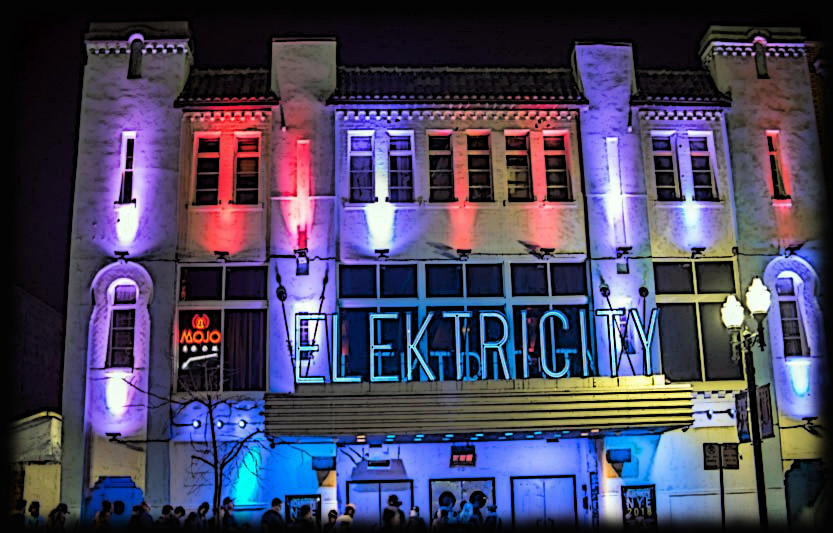
Live music has been a prominent feature of Detroit's nightlife since the late 1940s, bringing the city recognition under the nickname 'Motown'. The metropolitan area has many nationally prominent live music venues. Concerts hosted by Live Nation perform throughout the Detroit area. Large concerts are held at DTE Energy Music Theatre and The Palace of Auburn Hills. The city's theatre venue circuit is the United States' second largest and hosts Broadway performances.
- Club Ishtar -- Lair of the Catharist Coven known as Money Shot.
- Club Venus
- Mannam Club
- Club Puerto Riqueno
- Club Celebrity
- Colony Club
- Rattlesnake Club
- Club Med Detroit
- Locker Room Lounge
- The Jazz Club Detroit
- Penthouse Club
- Detroit Yacht Club
- Irish-American Club Incorporated
- Bayview Yacht Club
Casinos
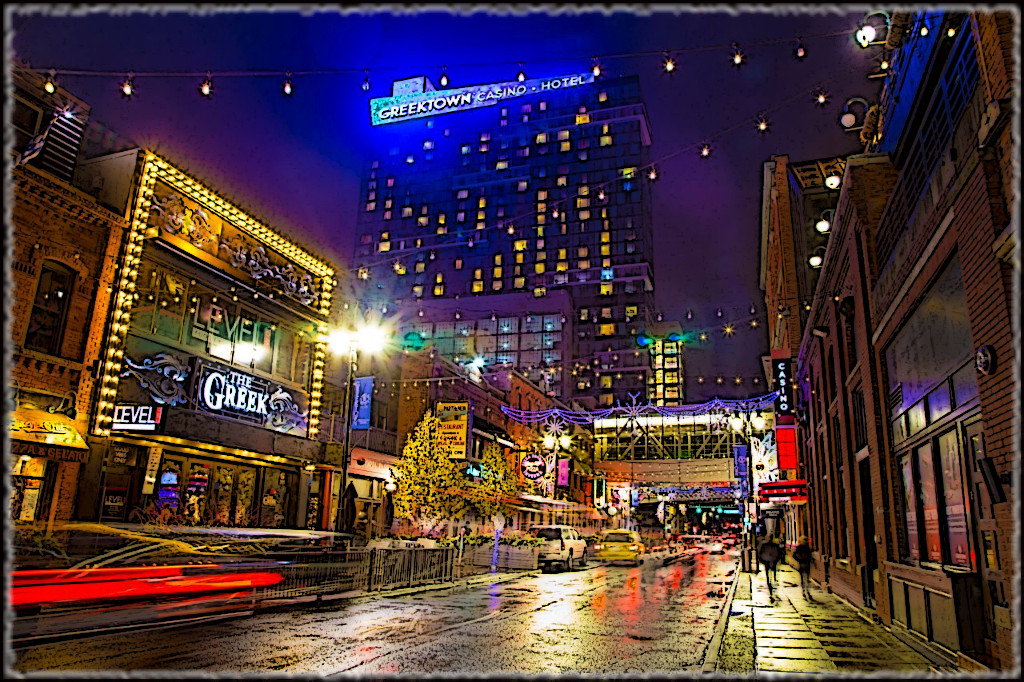
The city's Greektown and three downtown casino resort hotels serve as part of an entertainment hub.
Cemeteries
- Elmwood Cemetery -- As one of the oldest cemeteries in all of Michigan, the Elmwood Cemetery has been around since 1846.
- Eloise Cemetery
- Evergreen Cemetery
- Gethsemane Cemetery & Crematory
- Grand Lawn Cemetery & Mausoleum
- Holy Cross Cemetery & Mausoleum
- Mt Elliott Cemetery
- Mt Olivet Cemetery
- St Hedwig Cemetery & Mausoleum
- Trinity Cemetery
- Woodlawn Cemetery of Detroit
- Woodmere Cemetery & Crematorium
- Sources
- http://nighttraintodetroit.com/2013/08/05/every-cemetery-in-detroit-assumption-grotto/
- https://www.flickriver.com/photos/71288712@N00/sets/72157594492693427/
City Government

The city is governed pursuant to the Home Rule Charter of the City of Detroit. The city government is run by a mayor and a nine-member city council and clerk. Seven city council members are elected via district while two are elected at large. The mayor and clerk are elected in an at large election as well. Since voters approved the city's charter in 1974, Detroit has had a "strong mayoral" system, with the mayor approving departmental appointments. The council approves budgets but the mayor is not obligated to adhere to any earmarking. City ordinances and substantially large contracts must be approved by the council. The Detroit City Code is the codification of Detroit's local ordinances.
Mayor
- Kwame Kilpatrick -- See: Manoogian Mansion
City Clerk
The city clerk supervises elections and is formally charged with the maintenance of municipal records. Municipal elections for mayor, city council and city clerk are held at four-year intervals, in the year after presidential elections. Following a November 2009 referendum, seven council members will be elected from districts beginning in 2013 while two will continue to be elected at-large.
- [[]]
Justices
Detroit's courts are state-administered and elections are nonpartisan. The Probate Court for Wayne County is located in the Coleman A. Young Municipal Center in downtown Detroit. The Circuit Court is located across Gratiot Avenue in the Frank Murphy Hall of Justice, in downtown Detroit. The city is home to the Thirty-Sixth District Court, as well as the First District of the Michigan Court of Appeals and the United States District Court for the Eastern District of Michigan. The city provides law enforcement through the Detroit Police Department and emergency services through the Detroit Fire Department.
- [[]]
- [[]]
- [[]]
- Detroit Police Department -- (DPD) is a municipal police force responsible for the city of Detroit, Michigan. It was established in 1865.
- Detroit Fire Department -- (DFD) provides fire protection and emergency medical services to the City of Detroit, Michigan, United States.
The Future: Bankruptcy of Detroit 2013
On March 1, 2013, Governor Rick Snyder announced that the state would be assuming financial control of the city. A team was chosen to review the city's finances and determine whether the appointment of an emergency manager was warranted. Two weeks later, the state's Local Emergency Financial Assistance Loan Board (ELB) appointed an emergency financial manager, Kevyn Orr. Orr released his first report in mid-May. The results were generally negative regarding Detroit’s financial health. The report said that Detroit is "clearly insolvent on a cash flow basis." The report said that Detroit would finish its current budget year with a $162 million cash-flow shortfall and that the projected budget deficit was expected to reach $386 million in less than two months. The report said that costs for retiree benefits were eating up a third of Detroit’s budget and that public services were suffering as Detroit's revenues and population shrink each year. The report wasn't intended to offer a complete blueprint for Orr's plans for fixing the crisis; more details about those plans were expected to emerge within a few months.
After several months of negotiations, Orr was ultimately unable to come to a deal with Detroit's creditors, unions, and pension boards and therefore filed for Chapter 9 bankruptcy protection in the Eastern District of Michigan U.S. Bankruptcy Court on July 18, 2013, the largest U.S. city ever to do so, with outstanding financial obligations to more than 100,000 creditors totaling approximately $18.5 billion. On December 10, 2014, Detroit successfully exited bankruptcy.
Crime
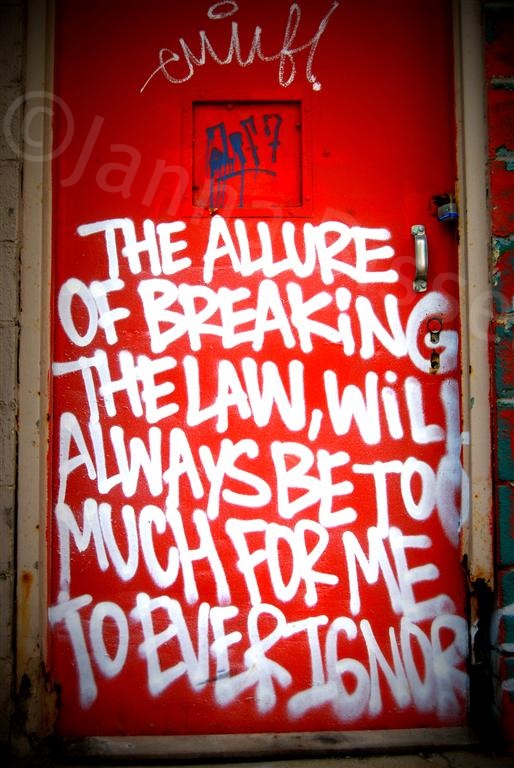
Quote: "Victims; aren't we all..." -- Eric Draven [The Crow 1994]
Detroit has some of the highest crime rates in the United States, with a rate of 62.18 per 1,000 residents for property crimes, and 16.73 per 1,000 for violent crimes (compared to national figures of 32 per 1,000 for property crimes and 5 per 1,000 for violent crime in 2008). Detroit's murder rate was 53 per 100,000 in 2012, ten times that of New York City. A 2012 Forbes report named Detroit as the most dangerous city in the United States for the fourth year in a row. It cited FBI survey data that found that the city's metropolitan area had a significant rate of violent crimes: murder and non-negligent manslaughter, rape, robbery, and aggravated assault.
According to Detroit officials in 2007, about 65 to 70 percent of homicides in the city were drug related. The rate of unsolved murders in the city is at roughly 70%.
Devil's Night
History
Devil's Night dates from as early as the 1940s. Traditionally, city youths engaged in a night of mischievous or petty criminal behavior, usually consisting of minor pranks or acts of mild vandalism (such as egging, soaping or waxing windows and doors, leaving rotten vegetables or flaming bags of Canine feces on front porch stoops, or toilet papering trees and shrubs) which caused little or no property damage.
However, in the early 1970s, the vandalism escalated to more destructive acts such as arson. This primarily took place in the inner city, but surrounding suburbs were often affected as well.
The crimes became more destructive in Detroit's inner-city neighborhoods, and included hundreds of acts of arson and vandalism every year. The destruction reached a peak in the mid- to late-1980s, with more than 800 fires set in 1984, and 500 to 800 fires in the three days and nights before Halloween in a typical year.
Angel's Night
By the early 1990s, Detroit saw little decline in Devil's Night arson. After a brutal Devil's Night in 1994, then-mayor Dennis Archer promised city residents arson would not be tolerated. In 1995, Detroit city officials organized and created Angels' Night on and around October 29–31. Each year as many as 50,000 volunteers gather to patrol neighborhoods in the city. As a result of the efforts, fires plunged to near-ordinary levels in the first decade of the 21st century.
In 2010 the number of reported fires climbed to 169, a 42 percent increase compared to the previous year. However, subsequent years saw the totals again decline to the low 90s for the three-day period. This average of about 32 fires per day is somewhat higher than the expected 26 fires per day through the year. 2015 saw the lowest recorded number of fires with only 52 fires recorded and only 24 considered possibly arson.
In the 2010s, the decline of Devil's Night fires has coincided with a rise in similar arson on the nights surrounding the July 4 Independence Day holiday.
Gangs of Detroit
Law enforcement and other agencies cannot provide the specific number of gangs currently active in Detroit, Mich., because Detroit’s gangs primarily are neighborhood-based, forming and dissolving on an ongoing basis. There are at least 2,500 confirmed gang members in Detroit, as reported to CBS Local.
While Detroit has a few gangs with nationally known names, such as the Latin Counts, most local gangs revolve around a school district or some other neighborhood affiliation. As of Aug. 2013, roughly one in every 28 Detroit residents was connected to gang activity, according to the head of the Detroit Crime Commission.
Some local Detroit gangs include the Errol Flynns, the Dexter Boys and the 7-Mile Boys, as of 2015. One of the most organized gangs to come out of Detroit was the Young Boys Inc. The Young Boys Inc. was established in the 1970s and quickly gained control of more than 80 percent of the Detroit heroin market. At one point, the gang was grossing over $250,000 in sales of narcotics. However, the most notorious gang to come out of Detroit is the Black Mafia Family. This gang has spread all over the United States and the correctional system, controlling much of the drug trade within.
- Sons of Santos -- Had a run-in with Tremen Hall and the Forsaken
Motorcycle Gangs
Rival Gangs
https://detroit.cbslocal.com/2013/10/31/gangs-of-detroit-examining-youth-violence/
http://gangsterreport.com/biker-gangs-in-the-motor-city-a-history-of-riding-rough/
https://gangsterreport.com/the-story-of-detroits-chambers-brothers-the-real-crack-commandments/
Citizens of the City
Academics
 -- Hawa El-Amin, PHD & Curator of Brush House Museum
-- Hawa El-Amin, PHD & Curator of Brush House Museum
Criminals
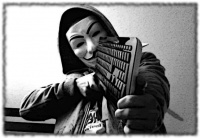 -- Anonymous -- Detroit's most notorious hacker.
-- Anonymous -- Detroit's most notorious hacker. -- Don Leprechaun -- The Green Pimp-Daddy.
-- Don Leprechaun -- The Green Pimp-Daddy.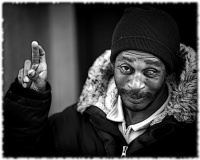 -- Sebbastyen Coombs -- A local scavenger who sells his salvage to who ever can meet his price. It was Coombs who found the videotape and sold it to the Sons in the first place.
-- Sebbastyen Coombs -- A local scavenger who sells his salvage to who ever can meet his price. It was Coombs who found the videotape and sold it to the Sons in the first place.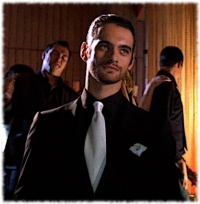 -- Vlasis Ioannidis -- Greek Mafioso
-- Vlasis Ioannidis -- Greek Mafioso -- Martin Santos -- Thug-like leader of the Sons of Santos.
-- Martin Santos -- Thug-like leader of the Sons of Santos. -- Toma Santos -- A Son of Santos lieutenant and cousin to Martin.
-- Toma Santos -- A Son of Santos lieutenant and cousin to Martin. -- Tasarla Zujenia -- Roma Vadoma
-- Tasarla Zujenia -- Roma Vadoma
Entrepreneurs
- [[]] -- Manuel Moroun -- Detroit Billionaire
The Faithful
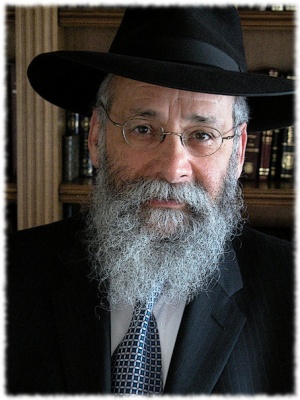 -- Rabbi Avishai -- Rabbi
-- Rabbi Avishai -- Rabbi
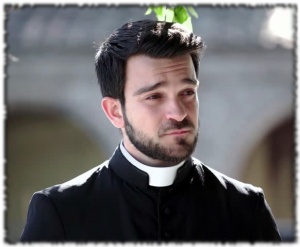 -- Zbigniew Wojewódka -- Polish Catholic Priest
-- Zbigniew Wojewódka -- Polish Catholic Priest
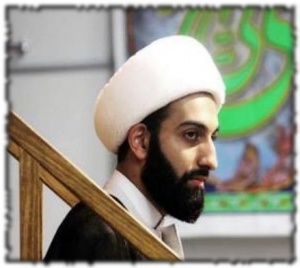 -- Khurshid Alinejad -- Persian Iman
-- Khurshid Alinejad -- Persian Iman
Police
 -- Capricia Millhouse -- Detroit police detective
-- Capricia Millhouse -- Detroit police detective -- Eben Stern & Felipa Echeverría -- Two Detroit beat cops.
-- Eben Stern & Felipa Echeverría -- Two Detroit beat cops.
Others
- [[]]
- [[]]
- [[]]
- [[]]
- [[]]
- [[]]
- [[]]
- [[]]
- [[]]
- [[]]
- [[]]
Current Events
Fortifications
Galleries
[[]]
Downtown
- David Klein Gallery
- Library Street Collective
- Presence II Productions
- Start Gallery
- The Carr Center
- WCCCD Art Gallery
East Side
- Heidelberg Project
Eastern Market
- Inner State Gallery
- K.OSS Contemporary Art
- Liberal Arts Gallery
- Michigan Artisans
- Red Bull House of Art
- Playground Detroit
- Salt & Cedar Letterpress
- Signal Return Press
- Trinosophes
- Wasserman Projects
Livernois / Uptown
- Eric’s I’ve Been Framed
- Detroit Fiber Works
- Jo’s Gallery
- NCA Gallery
- Sherwood Forest Art
- Marygrove College Gallery
North End
- Cave Gallery
- Gallery 17
- Michael Jon Gallery
- Russell Industrial Center
Midtown
- The Baltimore Gallery
- Cass Cafe
- Charles H. Wright
- Museum of African American History
- College for Creative Studies Galleries
- Dell Pryor Gallery
- Detroit Artists Market
- Detroit Institute of Arts
- Elaine L. Jacob Gallery
- Galerie Camille
- Heidelberg Project Midtown Office
- Ellen Kayrod Gallery
- LTG, Artist Studio & Showroom
- Museum of Contemporary Art Detroit
- N’Namdi Center for Contemporary Art
- Simone DeSousa Gallery
- Sugar Hill Clay Studio
- WSU Art Department Gallery
Southwest / Corktown
- Corktown Studios
- Holding House
- What Pipeline
- Whitdel Arts
- Baby Grand Gallery
Woodbridge / Grand River
- 4731 Gallery
- Live Coal Gallery
- MBAD’s African Bead Museum
- North End Studios
- Spread Art
http://artdetroitnow.com/galleries-and-museums/
Gymnasiums
Holy Ground

Quote: "Jesus Christ? Stop me if you heard this one. Jesus Christ walks into a hotel." [Fun Boy shoots him.] "He hands the innkeeper three nails, and he asks..." [Fun Boy shoots him again.]
[Funboy:] "Don't you ever fucking die?"
[Eric Draven:] "Can you put me up for the night?" -- [The Crow 1994]
- Cathedral Church of St. Paul of Detroit
- Central United Methodist Church of Detroit
- Christ Church Detroit
- First Baptist Church of Detroit
- First Congregational Church of Detroit
- First Unitarian Church of Detroit
- Fort Street Presbyterian Church of Detroit
- Historic Trinity Lutheran Church
- Mariners' Church
- Most Holy Redeemer Church of Detroit
- Our Lady of the Rosary Roman Catholic Church of Detroit
- Roman Catholic Archdiocese of Detroit
- Saints Peter and Paul Church of Detroit
- Second Baptist Church of Detroit -- located at 441 Monroe Street within Greektown, is the oldest African-American church in the Midwestern United States. It was designated a Michigan State Historic Site in 1974 and listed on the National Register of Historic Places in 1975.
- Ste. Anne de Detroit -- Founded 1701, is the second oldest continuously operating Catholic parish in the United States; it was the first building erected in Detroit.
- St. John's Episcopal Church of Detroit
- St. Mary Roman Catholic Church of Detroit
Hospitals
Within the city of Detroit, there are over a dozen major hospitals which include the Detroit Medical Center (DMC), Henry Ford Health System, St. John Health System, and the John D. Dingell VA Medical Center. The DMC, a regional Level I trauma center, consists of Detroit Receiving Hospital and University Health Center, Children's Hospital of Michigan, Harper University Hospital, Hutzel Women's Hospital, Kresge Eye Institute, Rehabilitation Institute of Michigan, Sinai-Grace Hospital, and the Karmanos Cancer Institute. The DMC has more than 2,000 licensed beds and 3,000 affiliated physicians. It is the largest private employer in the City of Detroit. The center is staffed by physicians from the Wayne State University School of Medicine, the largest single-campus medical school in the United States, and the United States' fourth largest medical school overall.
Detroit Medical Center formally became a part of Vanguard Health Systems on December 30, 2010, as a for profit corporation. Vanguard has agreed to invest nearly $1.5 B in the Detroit Medical Center complex which will include $417 M to retire debts, at least $350 M in capital expenditures and an additional $500 M for new capital investment. Vanguard has agreed to assume all debts and pension obligations. The metro area has many other hospitals including William Beaumont Hospital, St. Joseph's, and University of Michigan Medical Center.
In 2011, Detroit Medical Center and Henry Ford Health System substantially increased investments in medical research facilities and hospitals in the city's Midtown and New Center.
In 2012, two major construction projects were begun in New Center, the Henry Ford Health System started the first phase of a $500 million, 300-acre revitalization project, with the construction of a new $30 million, 275,000-square-foot, Medical Distribution Center for Cardinal Health, Inc and Wayne State University started construction on a new $93 million, 207,000-square-foot, Integrative Biosciences Center (IBio). As many as 500 researchers, and staff will work out of the IBio Center.
- [[]]
- [[]]
- [[]]
- [[]]
- [[]]
- [[]]
- [[]]
- [[]]
- Eloise (derelict psychiatric hospital) Eloise is one of several places seen in the visions that follow the viewing of the video tape and may be a significant clue as to why the visions are happening.
Hotels & Hostels
[[]]
- American Hotel of Detroit
- [[]]
- [[]]
- [[]]
- [[]]
Landmarks
- Ambassador Bridge -- is a tolled suspension bridge across the Detroit River that connects Detroit, Michigan, United States, with Windsor, Ontario, Canada.
- Belle Isle Boat House
- Book Tower
- Boston-Edison Historic District
- Chrysler House
- Detroit Club -- Originally formed in 1882 as a place where local businessmen could meet and mingle.
- Detroit River Light
- Fair Lane -- Home of Clara & Henry Ford
- General Motors Building
- GM Renaissance Center
- Grand Army of the Republic Building
- Guardian Building
- Harmonie Centre -- also known as the Breitmeyer–Tobin Building
- Harmonie Club of Detroit --
- Heidelberg Project
- Historic Fort Wayne
- James Scott Memorial Fountain
- Michigan Central Station
- Monument to Joe Louis
- Packard Automotive Plant
- Scarab Club
- Spirit of Detroit
- The Madison Building
- The Whiskey Factory
- US District Court for the Eastern District of Michigan
Literature
https://screenprism.com/insights/article/how-was-detroit-used-in-the-film
Mass Media
- Detroit Free Press
- Voice of Detroit -- The city's independent newspaper, unbossed and unbought
- [[]]
- [[]]
- [[]]
Monuments
[[]]
- [[]]
- [[]]
- [[]]
- [[]]
- [[]]
Museums
- [[]]
- [[]]
- [[]]
- [[]]
- [[]]
Parks
- [[]]
- [[]]
- [[]]
- [[]]
- [[]]
Private Residences
[[]]
- [[]]
- [[]]
- [[]]
- [[]]
- Manoogian Mansion -- is the official residence of the mayor of Detroit, Michigan. It is located at 9240 Dwight Street in the Berry Subdivision Historic District, on the city's east side, backing up to the Detroit River.
Restaurants
[[]]
- [[]]
- [[]]
- [[]]
- [[]]
- [[]]
- La Casa di Giovanni -- “An oasis in an industrial section of Detroit”
Ruins
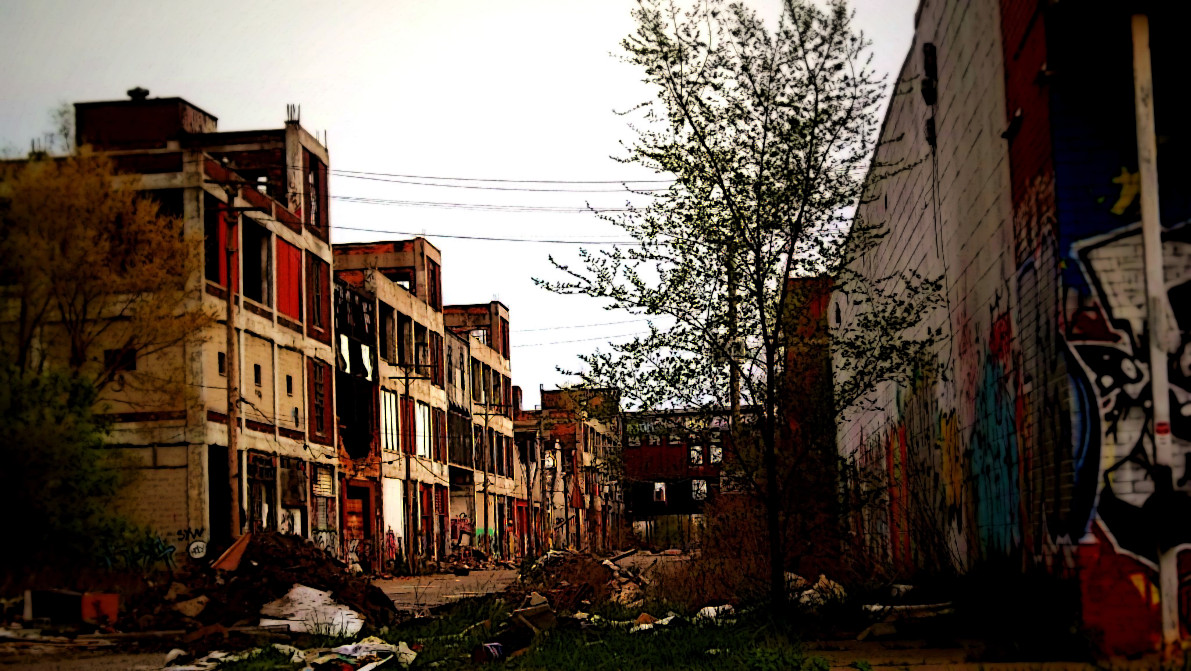
Urban Decay: Detroit has been described by some as a ghost town. Parts of the city are so abandoned they have been described as looking like farmland, urban prairie, and even complete wilderness.
A significant percentage of housing parcels in the city are vacant, with abandoned lots making up more than half of total residential lots in large portions of the city. With at least 70,000 abandoned buildings, 31,000 empty houses, and 90,000 vacant lots, Detroit has become notorious for its urban blight.
In 2010 Mayor Bing put forth a plan to bulldoze one fourth of the city. The plan was to concentrate Detroit's remaining population into certain areas to improve the delivery of essential city services, which the city has had significant difficulty providing (policing, fire protection, trash removal, snow removal, lighting, etc.). In February 2013 the Detroit Free Press reported the Mayor's plan to accelerate the program. The project has hopes "for federal funding to replicate it [the bulldozing plan] across the city to tackle Detroit’s problems with tens of thousands of abandoned and blighted homes and buildings." Bing said the project aims "to rightsize the city’s resources to reflect its smaller population."
The average price of homes sold in Detroit in 2012 was $7,500; as of January 2013 47 houses in Detroit were listed for $500 or less, with five properties listed for $1. Despite the extremely low price of Detroit properties, most of the properties have been on the market for more than a year as the boarded up, abandoned houses of the city are seldom attractive to buyers. The Detroit News reported that more than half of Detroit property owners did not pay taxes in 2012, at a loss to the city of $131 million (equal to 12% of the city's general fund budget).
The first comprehensive analysis of the city's tens of thousands of abandoned and dilapidated buildings took place in the spring of 2014. It found that around 50,000 of the city's 261,000 structures were abandoned, with over 9,000 structures bearing fire damage. It further recommended the demolition of 5,000 of these structures.
- Michigan Central Station -- Michigan Central Station (also known as Michigan Central Depot or MCS) was the main intercity passenger rail depot for Detroit, Michigan. Built for the Michigan Central Railroad, it replaced the original depot in downtown Detroit, which was shuttered after a major fire on December 26, 1913, forcing the still unfinished station into early service. Formally dedicated on January 4, 1914, the station remained open for business until the cessation of Amtrak service on January 6, 1988. At the time of its construction, it was the tallest rail station in the world. {Corktown} [Sabbat Communal Haven]
- Sources
- https://www.vice.com/en_us/article/ppzb9z/something-something-something-detroit-994-v16n8
- https://www.theguardian.com/housing-network/2016/feb/15/ruin-porn-detroit-photography-city-homes
- https://www.themotorlesscity.com/category/urban/
- http://www.urbanghostsmedia.com/2015/01/abandoned-places-urban-decay-detroit-ghost-neighborhoods/
- https://en.wikipedia.org/wiki/Ruins_photography
Schools
- Wayne State University -- Wayne State University School of Medicine
- [[]]
- [[]]
- [[]]
- [[]]
Shopping
- [[]]
- [[]]
- [[]]
- [[]]
Telecommunications
- [[]]
- [[]]
- [[]]
- [[]]
Theaters
Transportation
The Sabbat of Detroit
The Archbishop
The Bishops
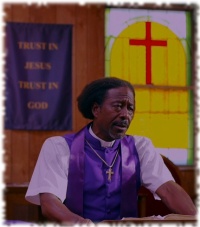 -- Anargyros Ansel -- Malkavian Antitribu
-- Anargyros Ansel -- Malkavian Antitribu -- D'con Charulz -- Brujah Antitribu
-- D'con Charulz -- Brujah Antitribu -- Lucrèce Boucher -- Tzimisce
-- Lucrèce Boucher -- Tzimisce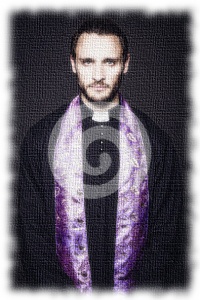 -- Heraclio Cardozo -- Lasombra
-- Heraclio Cardozo -- Lasombra -- Lady Seneca -- City Gangrel
-- Lady Seneca -- City Gangrel
The Rank and File
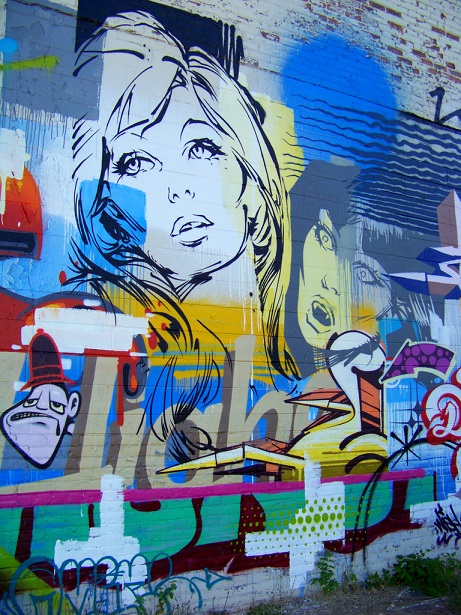
Introduction: Detroit is home to a combination of thirteen covens and packs, plus an additional three nomadic packs that visit the city seasonally. The city's eighty-plus Sabbat take their toll on the mortals of Detroit, through in truth, even the archbishop fails to keep a full tally of the Cainites of Motor City.
- American Gothic -- A Sabbat Biker Gang
- Cadillac Boys -- Motor City's Resident Hot-Rod Enthusiasts
- Canto XIII -- A Coven of Necronomists
- Eastside Hoodoo Posse -- White gangsta wannabees
- Finger Lickin' Good -- A Pack of Sabbat Addicts
- Gilded Age -- Detroit's Old Guard -- Survivors and Traitors to the Camarilla
- Just War -- A Pack of Blackhand freedom fighters.
- Los Jaguares -- The jaguars are a transplant pack from Jalisco, Mexico.
- Money Shot -- The Catharist Elite
- Order of St Philomena -- A religious cult of vampiric children led by a charismatic Malkavian called Father.
- Subterrestrials -- The subterrestrials are pack of underground explorers who rarely emerge from below Detroit.
- Tribe -- The tribe was originally formed from a cell of Black Panthers, but have degenerated into Detroit's premiere gangstas.
- Urban Blight -- Sabbat Artists
- Wolves of Detroit -- The First Coven of City Gangrel
Nomadic Packs
- The Forsaken -- A Nomadic pack from Chicago.
Those Who Have Suffered the Final Death
- Aurél Német -- Former Tremere regent {deceased}
- Get of Nyx -- This pack of young Lasombra were followers of the Path of Night before they vanished during the 1967 riots and the Sabbat takeover of Detroit. {deceased}
- Rainbow Serpents -- A Haitian pack of Serpents of the Light who vanished in the summer of 1981. {deceased}
Les Restes
- Chess 4 Hire -- Ahrimane Survivor
- Gudrun -- Gargoyle & Camarilla spy
- Oliver Young -- Inconnu monitor
Mysterious Objects
- Dark Idol of Detroit
- Strasbourg Codex -- A 600 year old tome of necromancy.
Wraiths of Detroit
- Bulus Barakat -- The Harbinger
Stories
[[]]
Sounds of Detroit
- A tribute to Detroit - Classic Techno mix (https://www.youtube.com/watch?v=9dHsl9d1t0M)
- Techno vs. Detroit °Vinyl Mix° (https://www.youtube.com/watch?v=GQWeF8nD6Cg)
- KENNY LARKIN Detroit techno set in The Lab LA (https://www.youtube.com/watch?v=135U14qF3Ag)
Soundtracks
https://www.youtube.com/watch?v=MUZV_KLiCJA&list=PL_uLk8hcBPt4nWz0FvMBiDSMQdC0xoroT&index=2&t=0s
https://www.youtube.com/watch?v=azeh1ZbxWwI&list=PL_uLk8hcBPt4nWz0FvMBiDSMQdC0xoroT&index=3&t=0s
https://www.youtube.com/watch?v=fHAi_-DOy40&list=PL_uLk8hcBPt4nWz0FvMBiDSMQdC0xoroT&index=4&t=0s
https://www.youtube.com/watch?v=U8THGNfWYh0&list=PL_uLk8hcBPt4nWz0FvMBiDSMQdC0xoroT&index=5&t=0s
https://www.youtube.com/watch?v=4ber5Dd6KFY&list=PL_uLk8hcBPt4nWz0FvMBiDSMQdC0xoroT&index=6&t=0s
https://www.youtube.com/watch?v=e-fv4bQobpc&list=PL_uLk8hcBPt4nWz0FvMBiDSMQdC0xoroT&index=7&t=0s
https://www.youtube.com/watch?v=7DMJZSTGPXg&list=PL_uLk8hcBPt4nWz0FvMBiDSMQdC0xoroT&index=8&t=0s
https://en.wikipedia.org/wiki/List_of_songs_about_Detroit (Songs about Detroit)
https://www.youtube.com/watch?v=3KB54p8_wh8&list=RD3KB54p8_wh8&start_radio=1 {Oh yes, Keith, you want to listen to this one...}
https://www.youtube.com/watch?v=3KB54p8_wh8 While the City Sleeps -- MC 900 Ft Jesus (1991) -- Detroit's Theme Song
https://www.youtube.com/watch?v=EUY2kJE0AZE {White Rabbit - Jefferson Airplane - 1967}
https://www.youtube.com/watch?v=iZq3i94mSsQ {Detroit Rock City}
Websites
http://en.wikipedia.org/wiki/Detroit
http://abigailanddolley.blogspot.com/2009/12/detroit-case-study-part-1.html
http://www.angelfire.com/de2/detroitpix/
http://www.detroitno2.com/v2/discussions/detroit-masonic-temple-from-grandeur-to-ghetto/
http://thereafterish.com/tag/theatre-bizarre/
http://www.inexpensive-vacation-ideas.com/Things-to-do-in-Detroit.html
http://ijr.com/2016/08/678564-driving-through-detroit-at-night-viral-video-shows-the-stunning-decay-of-a-once-thriving-city/ {Want to see Detroit in the World of Darkness / or the worst neighborhoods of real Detroit?}
http://ilovedetroitmichigan.com/
Devil's Night
https://en.wikipedia.org/wiki/Devil%27s_Night
Images
http://detroitfunk.com/fordson-island/
Movies
https://www.quotes.net/movies/the_crow_quotes_13268 [Crow Movie Quotes]

